SUPERSTAR
STRONG & STUNNING PLANTS FOR TEXANS


WHAT IT TAKES TO BE A ®
SUPERSTAR
It isn’t easy to become a Texas Superstar® plant. Only the toughest, most reliable and bestlooking plants make the cut. Every plant earning the Texas Superstar® designation undergoes several years of extensive field trials by Texas A&M AgriLife Research and the Texas A&M AgriLife Extension Service, both part of the Texas A&M System. They must show superior performance under Texas’ tough growing conditions. During the field trials, plants receive minimal soil preparation, reasonable levels of water and no pesticides.
What does this mean to the average homeowner? It means you will find landscape success with beautiful, proven, Texas-tough plants. Find these plants at your local nursery and be sure to look for the Texas Superstar® logo on the plant tags. Visit TexasSuperstar.com for additional details.

The term “Texas Superstar” is a registered trademark of Texas A&M AgriLife Research, Texas A&M System.
texassuperstar.com
 GO TEXAN is the Texas Department of Agriculture’s program promoting the products, culture and communities that call Texas home. As a mark of Lone Star pride, the GO TEXAN logo–a glowing brand in the shape of Texas–can be found on everything from floral products and grapefruits to cowboy boots and retirement destinations. For more information, visit gotexan.org.
GO TEXAN is the Texas Department of Agriculture’s program promoting the products, culture and communities that call Texas home. As a mark of Lone Star pride, the GO TEXAN logo–a glowing brand in the shape of Texas–can be found on everything from floral products and grapefruits to cowboy boots and retirement destinations. For more information, visit gotexan.org.

ANNUALS
Annual plants are plants with a life cycle that lasts only one year. They grow from seed, bloom, produce seeds, and die in one growing season. They then need to be replanted each spring.
Most annuals bloom for a long time. They provide beautiful colors from spring through fall and are popular with flower gardeners.

‘Allyson’ Mexican Heather
Cuphea hyssopifolia ‘Allyson’
USDA Zone 9-11
‘Allyson’ Mexican Heather is a multistemmed annual with an upright spreading growth habit which blooms a plethora of petite rosepurple flowers from spring to the first hard frost. Its medium texture blends well into the garden and can always be complimented by a couple of finer or coarser plants for an effective configuration. This plant has not only been a favorite in Texas gardens for many years but is also one of the top plants in attracting bees and butterflies.
Exposure: Ideally grows and blooms in full sun, but late afternoon summer shade is always preferred.
Height: Grows 12 to 18 inches tall and 16 to 18 inches wide.
Plant type: Grown best as a seasonal annual, especially from late spring to the first frost. However, they often re-sprout late the following spring from their crowns after a mild winter; but new spring plantings always outperform carry over plants.

Planting time: Plants are readily available in the spring through the summer months starting with 4 1/2 inch or quart size containers progressing later in the season to larger 10” hanging baskets and patio specimens.
Soil type: For landscape plantings, amending the native soil with liberal amounts of a landscape mix containing finished compost is ideal. Container specimens should be grown with a peat based premium potting mix that is cut with about 20% finished compost. Incorporating copious amounts of an appropriate slowrelease fertilizer at the time of planting will help insure vigorous growth and a profusion of flowers. Supplementing every 10 to 14 days throughout the growing season with a water-soluble fertilizer is also beneficial.
Suggested uses: Mass bedding, mixed borders, mixed containers, butterfly gardens, pollinator gardens, stand-alone patio specimens and hanging baskets.
Special notes: Benefits from mulching and regular summer irrigation but does not tolerate standing water. It is also referred to as false heather.

Angelonia, Summer Snapdragon

Angelonia angustifolia Serena series
Angelonia is a spreading annual with upright flower spikes that resemble minature snapdragons. The Serena series are the only angelonias that are grown from seed. Flower colors available include white, pink, purple, lavender and lavender pink. They flower all season long until frost. Angelonia can be used as a border planting, a ground cover or as a trailing plant for mixed containers.
Exposure: Full sun.
Height: 12–18 inches.
Plant type: Annual.
Planting time: Spring.
Soil type: Most soil types, as long as well drained.
Suggested uses: Mass bedding or ground cover, mixed borders and containers.
Special notes: Very reliable performer in all areas of Texas; tolerates heat well.
“Baby’s Breath” Euphorbias
Euphorbia hypericifolia (syn. Chamaesyce hypericifolia)
These Euphorbias are very finely textured, rambling annuals that present the appearance of a cloud of white in the landscape. Very wellsuited for the hot Texas summers, these unusual plants perform best as edging, ground cover and mixed container plants. Several varieties performed well in the Texas Superstar® trials, including “White Manaus,” “Breathless White,” “Silver Fog” and “Hip Hop.”
Exposure: Full sun.
Height: 12–18 inches.
Plant type: Annual.
Planting time: Spring.
Suggested uses: Edging, ground cover and mixed container plants.
Special notes: Very useful for blending other flowering plants together in either mixed borders or mixed container plantings. Flowers heavily through the summer until frost.
ANNUALS
'Blue Daze' Evolvulus glomeratus
USDA Zone 9-11
'Blue Daze' Evolvulus glomeratus is a heat and sun loving low spreading annual. Growers are rewarded with summer long flowers in a beautiful sky blue hue. The brilliant blue funnel-shaped flowers are small but plentiful and presented on a backdrop of grey green foliage. ‘Blue Daze’ will thrive in those garden hotspots that threaten species that are less hardy.
Exposure: Ideally grows and blooms in full sun. Flowering is reduced in areas that are too shady. ‘Blue Daze’ is tolerant of salty conditions and should be considered for coastal gardens.
Height: Grows 9 to 18 inches tall and spreads to 36 inches wide.
Plant type: Generally grown as an annual where frost is experienced. Tender perennial in USDA Zones 9-11.
Planting time: Plants are readily available in the spring through the summer months starting with 4 1/2 inch or quart size containers progressing later in the season to larger 10” hanging baskets.
Soil type: “Blue Daze” requires a moist soil that is well drained. Wet plants can quickly contract fungal diseases that will severely shorten their life span. A wide range of soils is tolerated including poor and sandy soils.
Suggested uses: “Blue daze” is a spiller and works best when you need a quick spreading cascading groundcover for mass bedding, mixed borders, mixed containers or hanging baskets.

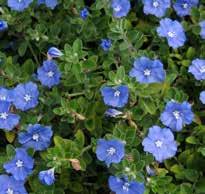
Special notes: Benefits from mulching and regular summer irrigation as long as the soil drains. This prolific bloomer benefits from monthly applications of fertilizer during the growing season.
Cool Season Euphorbias

Euphorbia martinii, E. characias subsp. wulfenii, E. amygdaloides
USDA Zone 6
These cold and drought-tolerant winter annuals provide mounds of color in the landscape from fall to spring. They are not fond of summer heat, but may behave as perennials in western Texas. For a tight mounding plant of bluish green foliage, select the ‘Tiny Tim’ variety. For variegated foliage, try ‘Ascot Rainbow.’ For more of a red or dark maroon color, try ‘Blackbird.’ ‘Rudolph’ has dark green foliage with red accents. ‘Tasmanian Tiger’ or ‘Glacier Blue’ is notable for excellent cream and green variegated foliage.
Exposure: Full sun to partial shade.
Height: 1–2 feet.
Plant type: Cool season annual.
Planting time: Late summer and fall. Soil type: Best in potting soil in containers but will perform in ground beds, if soil is very well-drained. Suggested uses: Best used in mixed containers, but also in well-drained landscape beds or rock gardens.
Special Notes: These plants are very pest and disease resistant. They are hardy to Zone 6 and hardy in containers, unless the temperature drops below 15° F. The most heat tolerant varieties are ‘Ascot Rainbow’ and ‘Tiny Tim.’
Dakota Gold
Helenium is a native Texas wildflower that now has improved cultivars for garden use. Once established, plants are Texas tough, continuing to grow and flower with little or no irrigation. Young plants are small flattened rosettes of foliage in the spring (or even late winter in southern locations) that develop strong tap roots. By mid-to-late spring, a canopy of thready dark green foliage develops and 1 inch diameter bright yellow composite flowers begin to appear. Flowering continues through autumn. The ‘Dakota Gold’ cultivar typically grows as low cushions of foliage topped with bright yellow flowers. Plants can be grown on most any well-drained soil with a sunny exposure. Good for low input landscapes where irrigation water is limited.
Exposure: Full sun.
Height: 6–8 inches.
Plant type: Reseeding annual.

Planting time: Anytime from containers.
Soil type: Well-drained slightly acidic soil is best, but it adapts to alkaline clay soils as long as drainage is adequate.
Suggested uses: Accent, border.
Helenium Helenium amarum ‘ Dakota Gold’Fall Zinnias

Zinnia x marylandica
Zinnia elegans
The Profusion and Zahara series of zinnia produce disease-resistant mounds of color that last until frost when planted in late summer. The more traditional flowers of the Dreamland and Magellan series can also be enjoyed at this time of year while avoiding the disease issues that can show up in the spring.
Exposure: Full sun.
Height: 12–18 inches.
Plant type: Annual.
Planting time: Late summer to early fall.
Soil type: Adaptable to soil type if well-drained and a variety of potting mixes.
Suggested uses: Mixed borders, mass bed displays and containers.
Special notes: Very heat tolerant; do not overwater.
Globe Amaranth

Gomphrena globosa
Globe amaranth (known by some as bachelor’s buttons) are versatile, often overlooked, summer annuals that thrive in the Texas heat. Varieties range in size from 8 to 48 inches, and vary in color from whites to pinks to lavenders to dark, rich purples. The All Around, Las Vegas, QIS and Audray series, and Fireworks varieties are good performers.
Exposure: Full sun.
Height: 1–4 feet and about as wide, depending on variety.
Plant type: Heat-loving, summer annual.
Planting time: Early summer after nights become warm.
Soil type: Well-drained; tolerates a wide range of soil types.
Suggested use: Mass plantings, combination plantings with other summer annuals such as salvia and Mexican mint marigold, and also make nice cut flowers for beautifying the indoors.
Lady Bird Johnson Royal Blue Bluebonnet
Lupinus texensis
A selection of the Texas state flower with a distinct royal (cobalt) blue color was named in honor of former first lady, Lady Bird Johnson; flowers are densely arranged on a spike with a characteristic ice white terminal tip.
Exposure: Full sun for optimum bloom.
Height: 12–14 inches.
Plant type: Annual.
Planting time: Sow scarified seed in the fall; if one misses the planting window, transplants can be set out in late winter.
Soil type: Numerous, but must be well-drained.
Suggested uses: Accent beds, meadows and hillsides, as well as containers.
Special notes: The distinct cobalt color sets this bluebonnet apart from the Texas Bluebonnet. It is a vigorous plant and will do best if spaced 12 inches apart. It tends to produce more seed than other bluebonnets, so it should easily naturalize in an area given proper care.
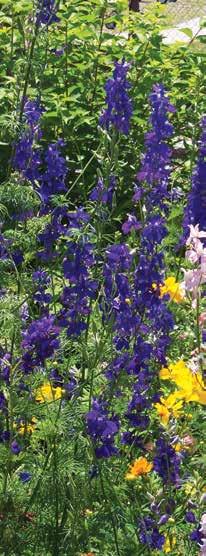

Larkspur
Consolida ambigua
USDA Zone 7
This reseeding annual has a backward-projecting spur, formed by the upper petal of the flower. The long spikes or panicles of flowers come in both single and double forms. Colors range from various shades of blue or purple-blue to pink and white. The soft, lacy foliage makes a great backdrop for the showy flower spikes.
Exposure: Full sun for best bloom; will tolerate partial shade.
Height: 36 inches.
Plant type: Reseeding annual.
Planting time: Fall.
Soil type: Well-drained soil.
Suggested uses: In bedding, window boxes, cut flowers and dried flowers.
Special notes: The Rocket Larkspur performs best in hardiness Zone 7, spaced 10–12 inches apart. Disease or pest problems are minimal if plants are grown in well-drained soils.
ANNUALS
Laura Bush Petunia
Petunia x ‘ Laura Bush’
USDA Zone 7
This is an old-fashioned reseeding petunia. It is more cold tolerant, disease resistant and heat tolerant than modern hybrids.
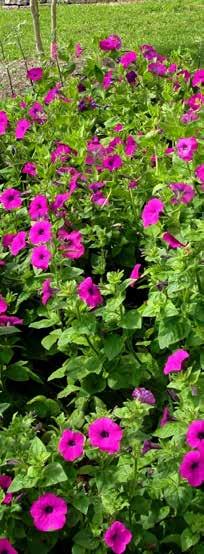
Exposure: Full sun.
Height: 24 inches.
Plant type: Annual.
Planting time: Spring and summer.
Soil type: Well-drained soil.
Suggested uses: Bedding, window boxes, patio containers and hanging baskets.
Special notes: The Laura Bush petunia performs best in hardiness Zone 7. It has a spreading growth habit with medium-size violet flowers. It grows best when transplanted 36 inches apart. This Texas Superstar® blooms from spring until frost. Between bloom cycles, prune back by 20 percent and lightly fertilize.
Mari-mum Tagetes erecta
There are several different varieties of African-type (largeflowered) marigolds such as the Antigua, Discover or Taishan series that can be used to produce the Mari-mum effect. The Mari-mum type marigolds bloom two to three times longer than chrysanthemums and are very low maintenance.

Exposure: Full sun.
Height: 8–16 inches.
Plant type: Annual.
Planting time: Transplant in late summer using plants with only tight flower buds showing and preferably no open flowers.

Soil type: Well-drained soil with organic matter.
Suggested uses: Mari-mums have such visual impact that they’re a wonderful choice for mass planting along the front edge of a flower bed, walk-way or garden path. Mari-mums also do extremely well in containers. Special notes: Applying 1–2 pounds of a slow release lawn fertilizer per 100 square feet of bed area will enhance blooming.
New Look® Celosia

(Celosia plumosa ‘New Look’)
USDA Zone 10-11
New Look® celosia is a plumed type commonly called feathered amaranth or feather celosia. It has bright red flowers soaring above dark, bronze foliage. The flowers are very long lasting and are continually produced throughout the summer season. Plants and flowers tolerate light shade and dry conditions when established and will stand up to a Texas summer much better than other celosias of this type. New Look® celosia lends an exotic look to the garden and can be used for bedding, in containers, and as a cut flower. This outstanding celosia has been on the market for many years and has stood the test of time in trial gardens across the state. Make sure you look for the name New Look® in order to get the new Texas Superstar® celosia.
Exposure: Full sun and will tolerate light shade.
Height: 10-14 inches.
Spread: 12-14 inches.
Plant Type: Warm season annual.
Planting Time: After the last frost date in spring to summer from containers. Soil type: Adapts to most soils, but needs good drainage.
Suggested uses: Bedding, containers alone or mixed, fresh or dried cut flower.
Special notes: Does best with good drainage and consistent moisture. Return flowering is greatly enhanced if old flowers are removed. Can be started from seed 6 to 8 weeks before the last frost date or direct sown in the garden after the last spring frost date.
Pentas
Pentas lanceolata
USDA Zone 9-11
Pentas are also known as Egyptian Star Flowers and have been a favorite in Texas gardens for many years. The cultivar Butterfly Deep Pink was promoted many years ago and the taller type Butterfly series are still classics. The Kaleidoscope series is another taller type that performs well. More compact types that are still vigorous enough to survive our hot summers are the Lucky Star and Graffiti 20/20 series which are more recent introductions with heavy flowering. Overall, the pink and deep pink colors seem to perform the best. But all pentas attract butterflies and hummingbirds!
Exposure: Full sun with late afternoon shade or at least some shade during the afternoon is best in Texas landscapes. Will tolerate partial shade well but flowering may be reduced.
Height: Taller types can reach 24 inches tall and wide, whereas the more compact types will be 12 to 16 inches tall and wide.
Plant type: Annual in Texas except in coastal areas and the Valley where temperatures never fall below freezing.
Planting time: Best in spring from 4 inch or quart size pots or larger as large plants establish more quickly. Plant early enough to allow for establishment before summer heat arrives.
Soil type: Tolerant of soil type but prefers a slightly alkaline pH with good drainage a must.
Suggested uses: Mass bedding, mixed borders, and mixed containers. Taller types can be used as cut flowers.
Special notes: Benefits from mulching and regular summer irrigation. Does not tolerate high saltwater, especially when irrigation is overhead.
Purslane
Portulaca oleracea, P. umbraticola, or hybrids

USDA Zone 10-11
Purslane makes a spreading groundcover with succulent leaves that are covered with flowers all summer long. They require full sun and a hot, dry location which in Texas is not hard to find. The flowers have iridescent colors which open with the sun and close at night. They can be used to carpet a bed or to spill from containers and baskets. The Cupcake series performs well and has spreading and upright forms. The Muffin series and Rio Grande series are also outstanding performers. The Toucan series can be grown from seed while the others are produced vegetatively.
Exposure: Full sun is needed for good flowering.
Height: Spreading types grow 4 to 10 inches tall with upright types slightly taller. Spread is 12 to 24 inches.
Plant type: Annual in Texas except in coastal areas and the Valley where temperatures never fall below freezing.
Planting time: Best in spring but can be planted in the summer. Larger plants are best when planting in the heat.
Soil type: Tolerant of soil type but needs good drainage. Allow the soil to dry slightly between watering.
Suggested uses: Mass bedding, edging for borders, as a spiller in mixed containers, window boxes, and hanging baskets. Will spill over the edge of raised beds.
Special notes: Flowers generally open during daylight hours though they may close somewhat earlier in extreme heat. Cupcake Cherry Baby is a cultivar that stays open a little longer during the day than others.
Rio Series Mandevilla
Mandevilla (syn. Dipladenia)

The Rio Series Mandevillas sport glossy foliage and broad, showy, trumpet- shaped flowers that come in pink, hot pink and deep red. These mandevillas grow upright with little twining. These compact plants grow best in patio containers and can be grown alone or mixed with other annuals wherever a splash of color is needed. They tolerate summer heat but also benefit from some afternoon shade.
Exposure: Full sun with afternoon shade.
Height: 1–2 feet in height and width. Plant type: Treat as a summer annual in most of Texas; perennial in south Texas.

Planting time: Spring or early summer. Soil type: Well-drained container mix or in soil bed with high organic matter and good drainage.
Suggested use: Accent plant in container on patio.
Special notes: Excellent plant around pools or wherever a colorful, tropic effect is needed.
Texas Bluebonnet Lupinus texensis
The Texas state flower is a hardy winter annual native to Texas. This species is the most commonly seen variety along roadsides and in pastures throughout the state. Flowers are densely arranged on a spike with a characteristic ice white terminal tip.
Exposure: Full sun.
Height: 12–24 inches.
Plant type: Annual.
Planting time: Fall.
Soil type: Well-drained soil.
Suggested uses: Flower beds, meadows and hillsides.
Special notes: The Texas bluebonnet, which blooms between March and May, has a blue flowering stalk that is tipped with white, just like a bunny’s tail. These hearty plants rarely suffer from insect and disease problems, however a well-balanced fertilizer applied in the fall will help with flower production.

ANNUALS
Texas Maroon Bluebonnet
Lupinus texensis, ‘Texas Maroon’ (syn. ‘Alamo Fire’)
A selection of the Texas state flower is a hardy winter annual native to Texas. Flowers are densely arranged on a spike with a characteristic ice white terminal tip.
Exposure: Full sun.
Height: 12–14 inches.
Plant type: Annual.
Planting time: Fall.
Soil type: Well-drained soil. Suggested uses: Bedding, window boxes, patio containers and hanging baskets.
Special notes: Texas maroon bluebonnets have a spreading growth habit and reddish-maroon flowers with a characteristic white terminal tip. It is recommended they are spaced 12 inches apart when transplanting or seeding.

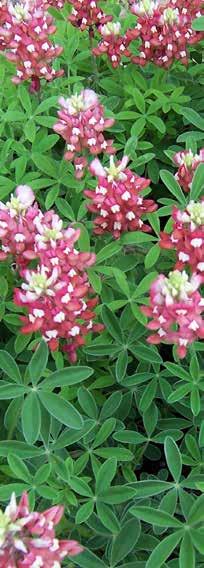
Tidal Wave® Red Velour
Spreading Petunia
Petunia x hybrida ‘PAS1085269’
USDA Zone 8b
As the name implies Tidal Wave® Red Velour Spreading Petunia offers dark red flowers that appear as if crafted of rich velour. This 12 to 24 inch tall dense canopied petunia spreads to 30 to 60 inches in width. Flowering is greatest from early spring to early summer and if well-tended can survive our summers and return for significant fall bloom. Tidal Wave® Red Velour combines well with its earlier designated fellow Texas Superstars® Tidal Wave® Silver Spreading Petunia (P. x hybrida ‘PAS97287’) and Tidal Wave® Cherry Spreading Petunia (P. x hybrida ‘PAS91421’) to offer great seasonal waves of Texas tough color. Exposure: Full sun exposure is best for floral display; partial shade may help in over-summering plants.
Height: Plants typically grow 12 to 24 inch tall with a spread of 30 to 60 inches.
Plant type: Typically grown as a fall (southern) or early spring (northern) cool to transition season annuals, but plants can be short-term perennials in USDA Hardiness Zone 8b. Summer temperatures can be limiting in warmer portions of the state, but Tidal Wave® Red Velour is more tolerant of heat than most petunias.
Planting time: Best in late winter or early spring in northern portions of our region once past severe freezes. Plants can be planted in late fall for periodic winter display in the warmer portions of the state. Growth in patio pots and containers is vigorous and will benefit from occasional shearing. Soil type: Almost any well drained soil; petunias benefit from regular fertilization.
Suggested uses: Tidal Wave® Red Velour Spreading Petunia can be used as a bedding, specimen, or an accent plant in mixed borders; plants are also effective in containers, hanging baskets, and window boxes.
Special notes: With adequate high quality irrigation water and a good fertility program, flowering can be maintained throughout the growing season in much of the state. Afternoon shade will help with summer endurance in warmer portions of the region.

Tidal Wave Silver and Cherry Petunia
Petunia x hybrida ‘Tidal Wave Silver’ and ‘Tidal Wave Cherry’
These petunias are more heat, disease and cold tolerant than typical grandiflora-type petunias. The vigor of these plants ensures a plentiful flower supply during the summer and into the fall.

Exposure: Full sun.
Height: 18–20 inches; can spread up to 4 feet.
Plant type: Annual.
Planting time: Spring and summer, can be planted in October/November for late-winter and early-spring flowering.
Soil type: Adaptable to different soil types; must be well-drained.
Suggested uses: Bedding, ground cover and large containers.
Special notes: Flowers are more vibrant if drip irrigation is used. Drought tolerant but benefits from regular watering and fertilization. If trimming is desired in mid-to-late summer, the plants can be lightly trimmed about 20 percent with a string trimmer. Water and lightly fertilize after trimming to stimulate growth and flowering.
White Stream Lobularia
Lobularia ‘White Stream’
White Stream is a new type of alyssum that will survive the heat of Texas summers. It is a spreading annual that makes good ground cover and produces fragrant flowers all summer. It is vegetatively propagated.

Exposure: Full sun for optimum flowering.
Height: 4–6 inches by about 12–18 inches wide.
Plant type: Annual.
Planting time: In early spring, after the danger of frost has passed, on 1-foot spacings.
Soil type: Tolerant of all soil types, as long as it’s well-drained.
Suggested uses: For the garden as ground cover or foreground planting; also useful as a spiller in mixed containers.
Special notes: Water use is moderate with limited tolerance to drought.
Whopper Begonias

Begonia x semperflorenscultorum
Whopper® Series
Wax begonias have long been a staple of Texas landscapes. This recently introduced series distinguishes itself with large leaves on large plants that have enormous flowers. They are outstanding in shade and partial shade, and will tolerate full sun except in extreme heat. Both green and bronze foliage types are available with red or rose flowers. “Everything is bigger in Texas” and Whopper begonias fit the bill!
Exposure: Partial to full shade; does well in morning sun and will tolerate full sun, except in extreme heat, especially with low relative humidity. Height: In shade can reach 24–30 inches with a 12–16 inch spread. Will be shorter and more compact with more sun.
Plant type: Annual.
Planting time: Best in spring just after frost but can be planted later. Will be more heat and sun tolerant if allowed to establish well before the summer heat. If planting in mid-summer, a shady location is advised.
Soil type: A well-prepared bed with organic matter and good drainage is best, but this plant is tolerant of many soil types. Should be kept moist but not too wet. Moderately drought tolerant.
Suggested uses: Excellent for mass bedding, in mixed borders and containers.
Special notes: Be careful not to overwater, especially if growing in containers.
Vinca Cora® Series
Catharanthus roseus
Cora and Nirvana vinca (commonly referred to as periwinkle) are the first varieties of this species to be resistant to the Aerial Phytophthora fungus, a devastating disease that until now limited the use of this species in Texas landscapes. In addition, they are heat and humidity tolerant and deer resistant. They are available in a wide array of colors with either upright or trailing habits and flower throughout the summer.
Exposure: Full sun, tolerates semi-shade.
Height: 14–18 inches.
Plant type: Annual.
Planting time: Late spring to summer.
Soil type: Adaptable to most soils.
Suggested uses: Bedding, containers, hanging baskets (trailing types) and window boxes.
Special notes: The best time to plant vinca is after the soil has thoroughly warmed in late spring or early summer. It does best in hot weather. It is drought tolerant, and needs good soil drainage and regular water and fertilization at moderate levels.

PERENNIALS
Perennials are plants that live more than two years. The term (per- + -ennial, “through the years”) is often used to differentiate a plant from shorter-lived annuals and biennials. The term is also widely used to distinguish plants with little or no woody growth from trees and shrubs.

‘Black Stockings’ Napier Grass
Pennisetum
USDA Zone 9a
Exposure: Full sun.
Height: Can grow from 8 to 12 feet tall.
Plant type: Can be perennial in panhandle if planted in a protected location. Used as an annual in north Texas and the High Plains.
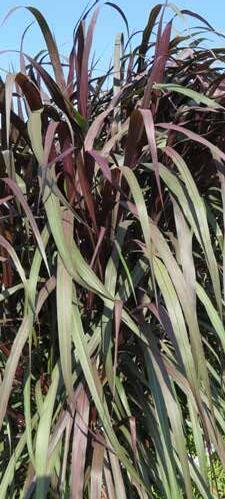
Planting time: Best in spring. Can be planted in summer from large containers.
Soil type: Almost any well drained soil.
Suggested uses: Best as a quick growing screen or background. plant.
Special notes: Plants freeze to the ground but make rapid growth in the spring to make a strong statement in the landscape. In north Texas, it can be overwintered if the temperatures are mild and it is grown in a protected location. Very little fertilizer is needed to get this plant to perform. Nitrogen fertilizer will cause the leaves to green up and lose the striking purple foliage that is a hallmark of this great plant. Cut back foliage when browned by frost as there is little winter interest.
Blue Princess Verbena
Glandularia x hybrida
‘Blue Princess’
USDA Zone 8b
This butterfly-attracting, easy care perennial has masses of beautiful, lavender blue flowers. It is also sold as ‘Princess Dark Lavender.’
Exposure: Full sun.
Height: 12 inches.
Plant type: Perennial.
Planting time: Spring.
Soil type: Well-drained soil.
Suggested uses: Bedding plant, containers, baskets, perennial border, and butterfly and hummingbird gardens.

Special notes: The Blue Princess Verbena blooms early spring through late fall. Shear between bloom cycles to promote new blooms. Rose Princess is also available.
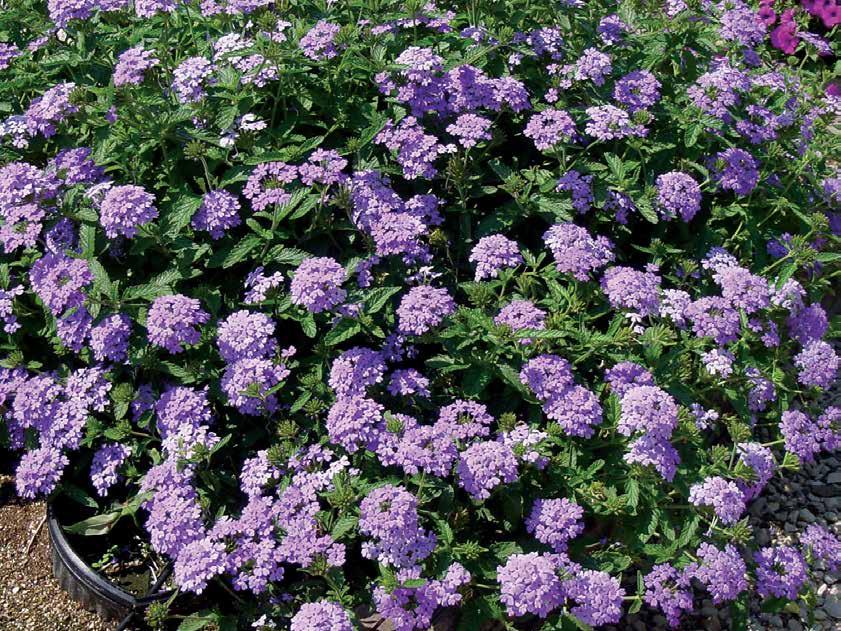
Cape Plumbago
Plumbago auriculata
USDA Zone 8b
Cape Plumbago produces profuse blue flowers and thrives in the hot Texas summer. It is sometimes called “sky flower,” because of the sky-blue color of its flowers. It flowers from May until the first frost.
Exposure: Full and partial sun.
Height: 4 feet.
Width: Up to 5 feet.
Plant type: Perennial.
Planting time: Anytime from containers.
Soil type: Adapts to most soils from acidic to moderately alkaline with moderate drainage.
Suggested uses: Container or accent plant.
Special notes: Dried flowers should be pruned from the Plumbago to encourage re-blooming and to maintain desired plant shape. It is excellent for attracting butterflies. It can handle hot, humid summers and is reasonably drought tolerant. The mperial Blue variety holds its color well.

Dwarf Mexican Petunia
Ruellia brittoniana
(Various dwarf cultivars)
USDA Zone 8
Under proper growing conditions, dwarf Mexican petunias produce compact, clumping mounds of dark green, lance-shaped leaves and bright, tubular flowers when in full bloom during the hottest part of the summer. When conditions are favorable, they will reseed, but the resulting plants retain the dwarf, clumping character.
Exposure: Full sun to partial shade.
Height: 6–8 inches.
Plant type: Herbaceous perennial or annual depending on the location.
Planting time: Spring to summer from containers.
Soil type: Adapts to most soils from acidic to moderately alkaline with moderate drainage.
Suggested uses: Accent, small scale groundcover, perennial borders, edging or mixed plantings.
Special notes: Dwarf Mexican Petunias are very adaptable and will tolerate both wet and dry soils. They prefer full sun but will grow in shade, though flowering will be less. Although dwarf Mexican petunias are drought tolerant once established, they perform best with regular irrigation during droughts and regular feeding of high phosphorus fertilizers.
PERENNIALS
Flare Perennial Hibiscus
Hibiscus x ‘ Flare’
USDA Zone 5
This herbaceous perennial has applegreen foliage and large iridescent fuchsia-red flowers that grow up to 10 inches wide.
Exposure: Full sun.
Height: 3–4 feet.
Plant type: Perennial.
Planting time: Spring.
Soil type: Any soil type, including high alkaline clays.
Suggested uses: Perennial border, butterfly and hummingbird gardens, and containers.
Special notes: Produces large leaves and is a profuse bloomer. It is also self-sterile, which encourages rebloom. The Flare Hibiscus will bloom from summer through the first frost.
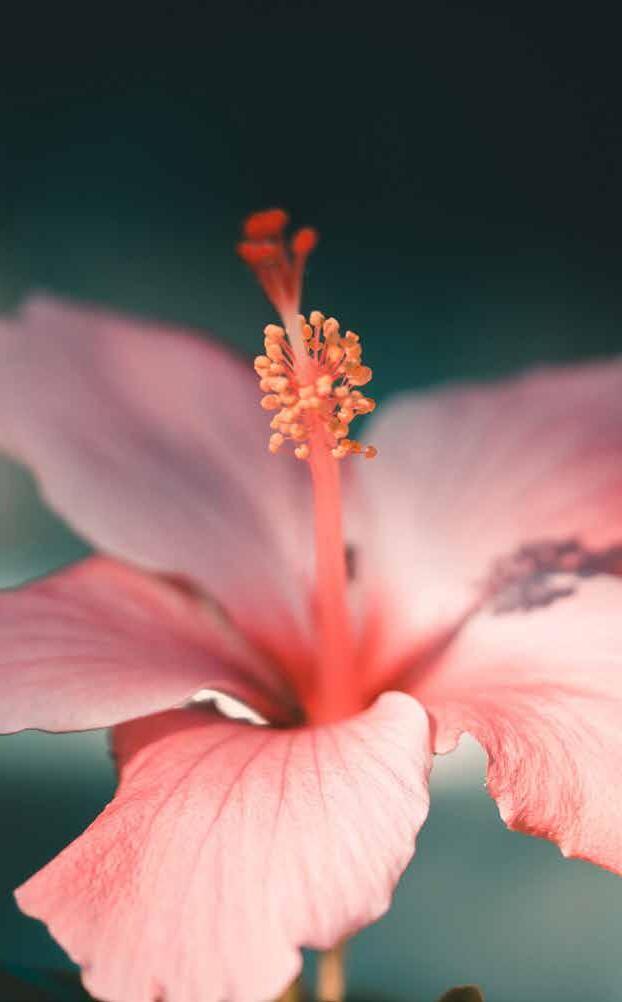

Gulf Muhly

Muhlenbergia capillaris
USDA Zones 6-9
Exposure: Full sun is suggested.
Height: 2 to 3 feet with pink blooms normally covering the top half of the plant’s height.
Plant type: Deciduous, upright mounding perennial grass.
Planting time: Container grown plants can be planted year-round.
Soil type: Well-drained sandy soils with low fertilizer levels work best, but the plants are adaptable.
Suggested uses: Pink muhly grass is low-maintenance and tough. These grasses naturally provide sanctuary to many small birds and pollinators. The mixed border would really benefit from the inclusion of gulf muhly. In addition, muhly grass is known to be deerresistant and largely free of ailments or pests.
Special Notes: Known for being incredible drought tolerance and the pink color of its inflorescences, this tough native grass is excellent for providing that shot of color as our summer beds fade from excessive heat. The airy pink profusion of blooms has been described as clouds, fireworks or a rose-colored fog.
Henry Duelberg Salvia
Salvia farinacea
USDA Zone 7
Henry Duelberg is a low-maintenance, heat-tolerant native plant that produces masses of showy blue flowers from spring until the first frost.
Exposure: Full sun.
Height: 3 feet x 3 feet.
Plant type: Perennial.
Soil type: Adapts to most soils.
Suggested uses: Bedding, containers, xeriscape, perennial border and cut flowers.
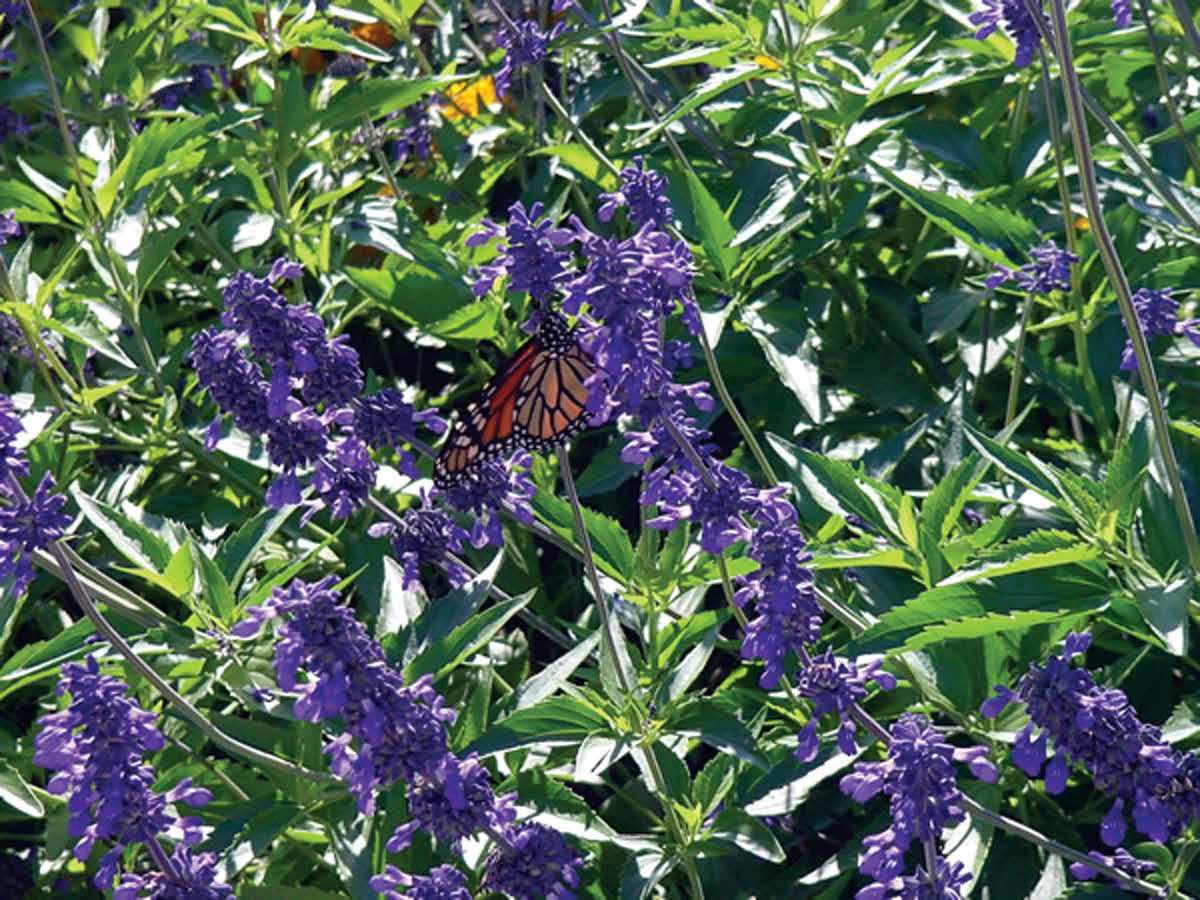
Special notes: Shearing frequently between bloom cycles will promote bloom development. Henry Duelberg is not preferred by deer.
Holly Fern
Cyrtomium falcatum
USDA Zones 6-10
Exposure: Partial shade is preferred, but can survive in full shade.
Height: 18-24” tall and slowly spreads to typical widths of 2’ to 3’, occasionally wider over time.
Plant type: Evergreen herbaceous shrubby perennial succulent.
Planting time: Container grown plants from early spring through fall.
Soil type: Moist but well drained soils are needed. Prefers a rich soil high in organic matter. A pH between 4.0 and 7.0 is highly preferred.
Suggested uses: Border or a ground cover plant. This low maintenance plant requires no pruning, however, fronds damaged by frost can be removed for a neater appearance.
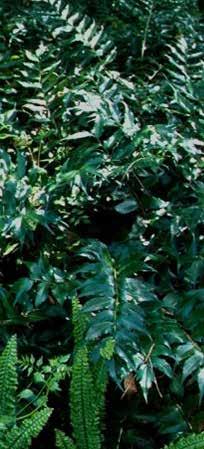
Special Notes: an easy to grow, stout, scaly evergreen fern. When mature, Holly fern displays stiff, glossy, dark green fronds with coarsely fringed margins on the leaves. Holly fern forms loose clumps of deep green leathery hollylike older leaves with light green new growth emitting from the center if the clump.
Phlox paniculata ‘John Fanick’
USDA Zone 4
Masses of fragrant, light pink flowers sporting a dark pink eye in the summer highlight this heat and drought resistant perennial. It blooms several weeks later than Victoria phlox and does not lodge as easily as Victoria. It is more disease resistant as well.
Exposure: Full sun for best bloom; will tolerate partial shade.
Height: 24–36 inches.
Plant type: Perennial.
Planting time: Spring.
Soil type: Well-drained soil.
Suggested uses: Specimen and background in perennial gardens and as a cut flower.
Special notes: The John Fanick Perennial Phlox has attractive evergreen foliage with a compact growth habit. This Texas Superstar® tolerates heat, drought and powdery mildew, but avoid overhead irrigation with salty water. Plants should be spaced between 24 and 36 inches apart. Cut back in late summer for fall blooms.
 John Fanick Perennial Phlox
John Fanick Perennial Phlox
PERENNIALS

Lindheimer’s Muhly Grass
Muhlenbergia lindheimeri
USDA Zone 7-11
Lindheimer muhly is a clump forming, tough, native Texas, perennial, warm season grass. Plants are semievergreen in warmer parts of our region, whereas in colder portions the foliage dies back to near ground level each winter. The rounded to fountainshaped canopy is composed of long arching aqua-green to blue-green, strap-like, keeled leaves. From summer to fall the canopy is topped by 8 to 18 inch long narrow flower panicles that open with a hint of purple-red, turning silver-white to gray-white as they mature, and eventually light brown or gray-brown as seeds ripen. This graceful native of live oak savannahs and limestone outcrops offers an urban tolerant native substitute for the exotic dwarf pampas grass (Cortaderia selloana) or Chinese silver grass (Miscanthus sinensis).
Exposure: Full sun is best, but plants will tolerate light shade.
Height: Foliage is typically 3–4 feet tall with flower stalks extending an additional foot above the foliage. Spread: 3–5 feet.
Plant Type: Warm season perennial bunchgrass.
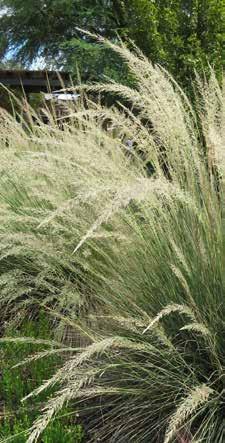
Planting Time: Bloom occurs over a long time frame from summer to early fall, spent fruiting structures are limitedly effective into late fall or early winter.
Soil type: Lindheimer muhly adapts to soils with a wide range of pH and soil textures, but needs reasonable drainage.

Suggested uses: Highly versatile Lindheimer muhly serves effectively as a specimen grass, intermediate size screen, background plant for summer annuals, a component of mixed sunny borders, and in groups for erosion control. Lindheimer muhly provides a great softening element for harsh landscape structures. The plumes of flowers are also effective in fresh or dried cut flower arrangements.
Special notes: Hardy to Zone 7 and possibly Zone 6, Lindheimer muhly functions best when pruned back to within a few inches of the soil prior to resumption of new growth in spring. Plants are very responsive to available water and fertility, but also can exist on nutrient poor or droughty sites.
Lord Baltimore Perennial Hibiscus
Hibiscus x ‘Lord Baltimore’
USDA Zone 5
This perennial has glossy foliage and large red flowers up to 10 inches wide.
Exposure: Full sun.
Height: 5 feet.
Plant type: Perennial.
Planting time: Spring.
Soil type: Prefers neutral to acid soils.
Suggested uses: Perennial border, butterfly and hummingbird gardens.
Special notes: The Lord Baltimore performs best in hardiness Zone 5. It has attractive foliage, provides stunning color, loves the heat and requires very little maintenance. It also has excellent pest and disease resistance, and works best with medium amounts of water.
Mexican Bush Sage
Salvia
leucanthaUSDA Zone 8
A tough, drought tolerant, highly pest resistant salvia with showy spikes of purple and white, or solid purple blossoms that appear in the fall. This works well as a cut flower.

Exposure: Full sun.
Height: 3–4 feet.
Width: 3 feet.
Plant type: Perennial.
Planting time: Spring or summer from containers.
Soil type: Adaptable, but needs excellent drainage.
Suggested uses: Accent, bedding and perennial borders.
Special notes: Plant these perennials in the southern half of the state. Stems are brittle so protect from high winds.
Moy Grande Perennial Hibiscus

Hibiscus x ‘Moy Grande’
USDA Zone 5
The giant-flowered rose mallow has the largest flowers of any hardy perennial. These are descendants of the native hibiscus found in Louisiana and other Gulf Coast states. Ying Doon Moy cross-bred a Hibiscus moscheutos hybrid with Hibiscus grandiflorus to create the largest, open-face hibiscus flower in the world.

Exposure: Full sun.
Height: 5 feet.
Plant type: Perennial.
Planting time: Spring.
Soil type: Well-drained soil containing plenty of organic matter and nutrients.
Suggested uses: Perennial border, butterfly and hummingbird gardens.
Special notes: Moy Grande will grow up to 5 feet wide, and bloom between May and September. Removing spent flowers and developing seed pods will promote rebloom. Flowers are usually 12 inches wide and have a rose-pink color. Moy Grande hibiscus will perform best in hardiness Zone 5.
PERENNIALS
Mystic Spires Blue Salvia

Salvia longispicata x farinacea
‘Mystic Spires Blue’
USDA Zone 7
Mystic Spires Blue Salvia is a compact form of another popular salvia called ‘Indigo Spires’. Though shorter than ‘Indigo Spires’, it flowers even more freely during the entire growing season. It produces masses of trueblue flowers that mix nicely with other annuals and perennials, is tolerant of heat and humidity (low and high), and is not bothered by pests or diseases or deer.
Exposure: Full sun.
Height: 18–30 inches.
Plant Type: Perennial.
Planting Time: Spring to summer from containers.
Soil type: Adapts to most soils, but needs good drainage.
Suggested uses: Bedding, containers, perennial border, cut flower.
Special notes: Mystic Spires Blue Salvia is hardy to USDA hardiness Zone 7 with good drainage. Excess water and fertilizer can result in excessive vegetative growth and lack of flowers. If needed, plants can be pruned during the growing season as reflowering occurs quickly. Shoots can be pruned to 12 inches or so in the fall after being killed by freezing but refrain from pruning to the ground until growth is strong in the spring.
New Gold Lantana
Lantana camera ‘New Gold’
USDA Zone 8b
The New Gold Lantana is a low maintenance plant with golden yellow flowers. It is drought and heat tolerant, and its reduced fruit set promotes prolific blooming from spring until frost.
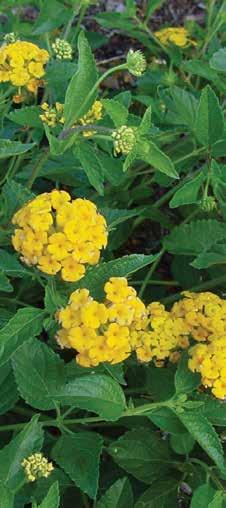
Exposure: Full sun.
Height: 12–24 inches.
Plant type: Small spreading woody shrub, herbaceous perennial or annual depending on the location.

Planting time: Spring to summer from containers.
Soil type: Adapts to most soils from acidic to moderately alkaline with moderate drainage.
Suggested uses: Accent, bedding, bank cover or patio containers.
Special notes: When well established, the plants are very drought tolerant and continue to produce bright and attractive blooms, even in the hottest weather. Whiteflies can sometimes be a pest. Prune annually for best results.
Pink Flare and Peppermint Flare
Perennial Hibiscus
Hibiscus x ‘Pink Flare’ and ‘Peppermint Flare’
USDA Zone 5
Part of the Flare Series, these showy perennials have large glowing fuchsia flowers. The offspring have the same superior traits as the original but, their colors are pink and peppermint (white with red stripes). Their maplelike emerald-green foliage is very attractive on compact plants that are practically sterile, which encourages continuous bloom.
Exposure: Full sun.
Height: 3–5 feet.
Plant type: Herbaceous perennial.
Planting time: Spring.
Soil type: Any soil type, including high pH clays.
Suggested uses: Perennial border, butterfly and hummingbird gardens, and containers.
Special notes: These flowers are great grown as complements with Flare, Moy Grande and Lord Baltimore hibiscuses with an expanded color range. Peppermint Flare offers an unusually striking twotone flower.
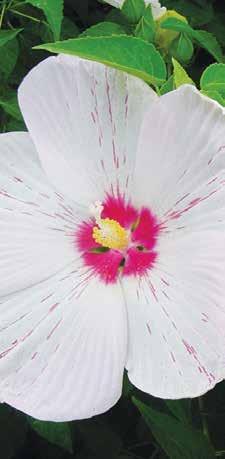
Princess Caroline’ Napier Grass
Pennisetum x ‘Princess Caroline’
USDA Zone 7
‘Princess Caroline’ has beautiful wide leaves that are a deep purple in color. It does not flower and is resistant to leaf spot that can be seen on older varieties. It is very heat and drought tolerant and is perennial in most of the state.
Exposure: Full sun.
Height: Grows from 4–6 feet tall depending on amount of watering and length of the growing season.
Plant type: Perennial in most of the state.
Planting time: Spring.
Soil type: Almost any well-drained soil.
Suggested uses: Specimen plant, accent plant in mixed borders or quick-growing screen.
Special notes: Plants freeze to the ground, but they grow rapidly in the spring to make a bold statement in any landscape. Hardy in north Texas if temperatures are mild and it is grown in a protected location. Very little fertilizer is needed for this plant to perform. Nitrogen fertilizer will cause the leaves to green up and lose the striking purple foliage that is a hallmark of this great plant.
Red Yucca
Hesperaloe parviflora
USDA Zone 6-13
Red yucca resembles a cross between our common spine-pointed yuccas and an aloe. Leaves are thicker than those of yuccas, but more sword shaped than those of aloe. These dark green leaves arise from a slowly suckering clump forming a cluster of rosettes. From these rosettes 4’ to 5’ long pale pink spikes or narrow sparsely branched panicles of coral, salmon-pink, or rarely red or yellow, 1’ to 2’ long, tubular flowers with trumpet-shaped flared tips are produced, often multiple times through the growing season. Flowers often occur as spikes on younger plants, with older established plants producing larger branched panicles. Foliage is evergreen and plants can be longlived. These showy neat plants are attractive year-round and serve as excellent pollinator support plants. Deadheading of spent flowers will improve plant appearance and avoid resource diversion to fruit development.
Exposure: Ideal plant for full sun, dry, and exposed locations.
Height: 12-18 inches tall and 2-3 inches wide.
Plant type: Evergreen herbaceous shrubby perennial succulent.
Planting time: Container grown plants from early spring through fall.
Soil type: Most soil types, as long as well drained.
Suggested uses: rock gardens and xeric landscapes, accents under light shade trees, and cover on dry, rocky slopes.
Texas Gold Columbine
Aquilegia chrysantha var. hinckleyana ‘Texas Gold’

USDA Zone 6
This cool season perennial has bright yellow, lightly fragrant spring flowers atop its long stems. Its gray-green foliage is evergreen in warmer climates.

Exposure: Filtered shade in the summer, and full sun in the winter and spring, such as found under the canopy of a deciduous tree.
Height: 18–24 inches.
Plant type: Cool season perennial. Planting time: Spring.

Soil type: Well-drained soil.
Suggested uses: Garden accent, specimen, hummingbird garden and container garden.
Special notes: The Texas Gold Columbine has an open clumping habit and grows as wide as 24 inches. It works best in full sun with medium water.
PERENNIALS
Tangerine Beauty Crossvine
Bignonia capreolata
USDA Zone 6
Known as crossvine due to the pattern inside its crosscut stem is a spring blooming evergreen vine native to Texas and the southeastern United States. In its common native form, this relative of trumpet creeper sports banana-yellow tubular flowers with maroon highlights. There are however selections with flower colors ranging from orange to red. Among the showiest and most available is the cultivar ‘Tangerine Beauty’ which was discovered growing in a garden in San Antonio by Texas horticulturist and garden writer Scott Ogden in the 1980s. It was subsequently named and introduced by the North Carolina State Arboretum in 1993. ‘Tangerine Beauty’ crossvine is commonly pollinated by ruby-throated hummingbirds and is known to scatter repeat blooms during the growing season.
Exposure: Heaviest bloom occurs in full sun.
Height: Up to 15 feet wide and tall.
Plant type: Vigorous, evergreen, clinging vine.

Planting time: Container grown plants can be planted year-round.
Soil type: Well to moderately drained soils are best. Plants are soil pH adaptable and can be grown in sand, silt, or clay. Crossvine will tolerate low fertility sites, but also will grow more vigorously where adequate nutrients are available. Drought and heat tolerance are excellent once plants are established.
Suggested uses: coving arches, fences, gazebos, pergolas, trellises, and walls. ‘Tangerine Beauty’ is a great addition to any landscape, particularly Earth-Kind®, native, organic, pollinator, and Wildscape gardens.

Trailing Lantana
Lantana montevidensis
USDA Zone 8b
Beautiful trailing or spreading perennial with a profusion of lavender, purple or white flowers that bloom consistently from spring through frost and attract butterflies. Outstanding heat, wind and drought tolerance.
Exposure: Full sun.
Height: 1 foot tall, 4 feet wide.
Plant type: Perennial.
Planting time: Spring to summer in containers.
Soil type: Adapts to most soils from acidic to moderately alkaline with moderate drainage.
Suggested uses: Mass bedding, ground or bank cover, and as a spiller over the edge of beds above garden walls or in containers.
Special Notes: Hardy to Zone 8b and resistant to lantana lacebug.
Turk’s
Cap
Malvaviscus arboreus var. drummondii
USDA Zone 7b
A rapidly growing, coarse- textured plant that produces a profusion of “turban-like” flowers in various colors ranging from bright red to pink to white. Flowers are produced all summer but are especially heavy in the fall. They attract hummingbirds and butterflies. Turk’s cap is native to south Texas, where it becomes an established perennial, but in north Texas, it is used as an annual. Turk’s Cap is very drought tolerant once established. The cultivar “Pam Puryear” has soft pink flowers.
Exposure: Sun or shade; flowers heavier in sun, but the foliage is more attractive with some shade.
Height: 3–6 feet with about equal spread.
Plant type: Perennial.
Planting time: Anytime from containers.
Soil type: Adaptable to most soils.
Suggested uses: Accent, perennial border, butterfly and hummingbird gardens, and deciduous hedge.
Special notes: Root-hardy perennial in most of Texas, including Zone 7b.

Victoria Perennial Phlox
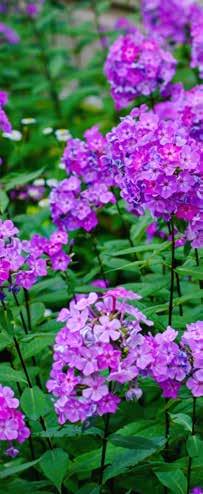

Phlox paniculata ‘Victoria’
USDA Zone 4
This heat and drought resistant perennial sports masses of purplishpink (magenta) flowers in the summer and in the fall (if cut back after summer bloom occurs).
Exposure: Full sun for best bloom; will tolerate partial shade.
Height: 24–36 inches.
Plant type: Perennial.
Planting time: Spring.
Soil type: Well-drained soil.
Suggested uses: Specimen and background in perennial gardens.
Special notes: The Victoria Perennial Phlox has an attractive evergreen foliage with a compact growth habit. It is a hardy perennial with showy clusters of magenta pink blossoms. It also has lighter green foliage and a more open growth habit than the John Fanick. This Texas Superstar® tolerates heat, drought and powdery mildew, but avoid overhead irrigation with salty water. Plants should be spaced between 24 and 36 inches apart. The ideal hardiness Zone is 4.
Yellow Butterfly Vine
Callaeum macropterum
USDA Zone 8b -10
The clusters of dainty flowers on butterfly vine shine as brilliant as the summer sun. But it’s the seed pods that give the plant its most common name. During summer and fall, chartreuse “wings” unfold on the seed pods that look like butterflies. The papery pods turn tan to brown as they mature. In mild winters, the vine will retain its glossy green foliage. Butterfly vine is drought tolerant and thrives in hot, sunny locations. It is highly resistant to both insects and disease.
Exposure: Hot sun to partial shade.
Height: 10–15 feet.
Spread: 10–15 feet.
Plant type: Perennial, twining, evergreen vine.
Planting time: Spring and summer from containerized plants.
Soil type: Butterfly vine is adapted to any well drained soil including both acidic and alkaline.
Suggested uses: Climbing on fences, trellises, and arbors, as well as spilling over walls and out of large containers.
Special notes: Native to Mexico. In colder areas of the state, butterfly vine can be grown as a herbaceous perennial (where the ground doesn’t freeze) or as a tropical annual container plant. Formerly known as Mascagnia macroptera and also called yellow orchid vine.

PER-ANNUALS
Per-annuals are tropical perennials used as annuals.
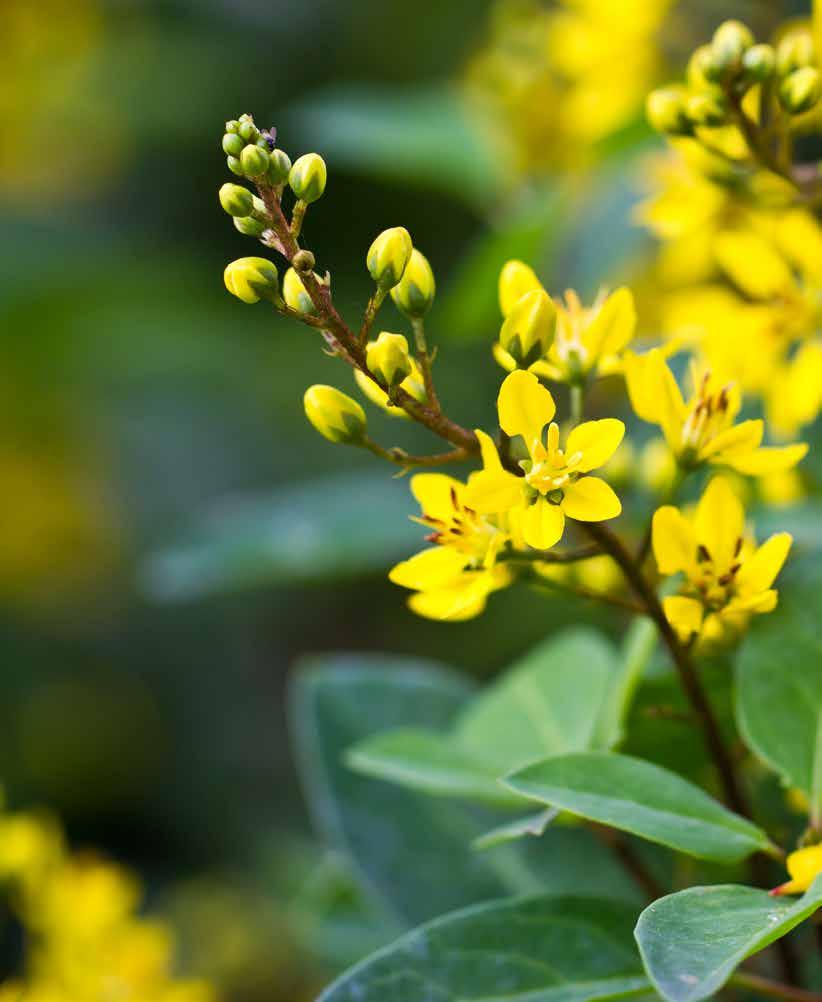
Brazilian Red Hots Alternanthera
Alternanthera dentata
‘Brazilian Red Hots’
Brazilian Red Hots are a dependable selection of the old-time Joseph’s Coat that grows with a mounded habit. The attractive, lively, hot pink and rose shaded foliage makes it a delightful addition to any Texas garden. It’s an easy to grow plant that prefers partial shade, but it can tolerate the Texas hot summer heat, if planted early in the spring. However, its attractive foliage color is most vibrant when it receives intense sunlight. The plants are somewhat drought tolerant once they are established. Supplemental irrigation in well-prepared soil may be needed to establish the plant. Though not the biggest feature of this plant and often inconspicuous, ball-shaped white flowers spring out above the foliage in the mid-winter in regions where there is no or little frost.
Exposure: Prefers partial shade in hot regions but will tolerate full sun well if planted early; can tolerate more sun in the northern part of the state.
Height: 24–36 inches tall with a 12–18 inch spread.
Plant type: Annual in most of Texas as it is sensitive to frost. In frost-free areas, it can be a short-lived perennial.
Planting time: Best in spring after frost; can also be planted in midsummer or fall if watered adequately for establishment.
Soil type: A well-prepared soil amended with organic material with good drainage is best, but will tolerate poor soils.
Suggested uses: Excellent as a standalone plant, whether planted as a mass border planting or accenting a repertoire of other popular Texas Superstar® selections, such as Cora Vinca, Butterfly Pentas, Serena Angelonia and Baby’s Breath Euphorbias. It will also complement combination plantings in containers. Special notes: Plants benefit from being cut back lightly as days become longer in late spring for a vigorous flush of summer color and possibly again in late summer for fall satisfaction.
Duranta
Duranta erecta
USDA Zone 9
Also known as Brazilian Sky Flower, is a rapid-growing, dense shrub with small glossy leaves and a profusion of pendulous racemes of small flowers varying in color from light blue to purple.

Exposure: Sun or shade; flowers heavier in sun.
Height: 12–15 feet in South Texas depending on pruning.
Plant type: Root-hardy perennial in South Texas, but annual or tender perennial in most areas of the state. Planting time: Anytime from containers.
Soil type: Adapts to most soils. Suggested uses: Can be used as a container plant or an accent plant in a landscape.
Special notes: Some selections fruit heavily, and the plant becomes covered with small, golden balllike drupes. Must be treated as an annual-root hardy perennial in most parts of Texas, but it will be perennial in South Texas. Brazilian Sky Flower blooms best from summer until the first frost.
Firebush
Hamelia patens
USDA Zone 9
Firebush offers real hope to heathammered summer landscapes. Once established, firebush is very heat and drought tolerant. Firebush is an evergreen shrub or small tree native to many areas in tropical and subtropical America.

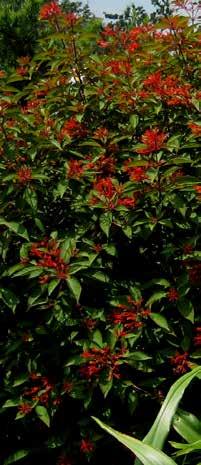
Exposure: Full sun.
Height: 18–30 inches.
Plant type: Annual from Central Texas northward, perennial in South Texas. Planting time: Set transplants from mid-May through summer months and space one foot apart.
Soil type: Almost any well- drained soil, even highly alkaline, heavy clays.
Suggested uses: Mass plantings with white blooming annuals, containers and hummingbird gardens.
Special notes: The firebush blooms between June and November with terminal clusters of scarlet red and tubular blossoms with deeper red throats. Its foliage turns to a blood red color in the fall. Firebush does not usually show signs of insect or disease damage when grown outdoors in a full sun location.
PER-ANNUALS
Firecracker Jatropha
Jatropha integerrima
USDA Zone 9
This subtropical evergreen shrub has glossy leaves and clusters of star-shaped bright scarlet or vermilion flowers. Jatropha is a spectacular shrub in bloom, which is most of the year in warmer portions of the state and spring to frost in colder locations.
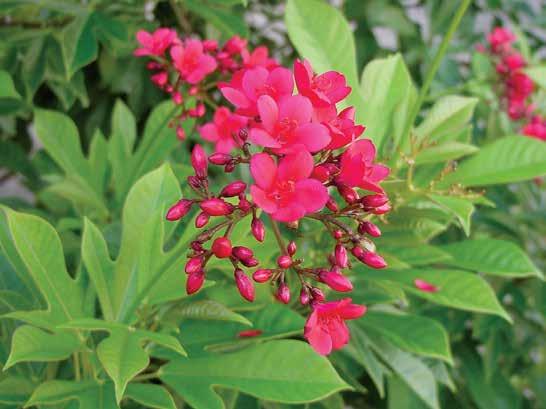
Exposure: Best flowering is in full sun, but plants will remain attractive in partial shade.
Height: In tropical climates, plants may grow 8–10 feet tall, but as patio plants or summer annuals, they are usually 3–5 feet tall.
Plant type: Summer annual where winters are cold, woody shrub along the coast and in south Texas.
Planting time: Spring after danger of frost has passed.
Soil type: Adapted to most well-drained garden soils and can be grown in a variety of potting mixes.
Suggested uses: Use as a summer accent where frosts are frequent or in a mixed shrub border where winters are warm. Use as a container plant to attract butterflies and hummingbirds.
Special notes: Fruit are reported to be poisonous, but appear to be seldomly produced in most Texas regions.
Gold Star Esperanza
Tecoma stans ‘Gold Star’
USDA Zone 9
This heat-loving, semi-evergreen shrub has golden-yellow ball-shaped flowers that bloom in late spring through fall.


Exposure: Full sun.
Height: 4 feet.
Plant type: Root-hardy perennial.
Planting time: Spring.
Soil type: Well-drained soil.
Suggested uses: Containers, flower beds, butterfly and hummingbird gardens.
Special notes: Gold Star esperanza is recommended for hardiness Zone 9. It has attractive glossy foliage and grows up to 3 feet wide. Gold Star esperanza requires medium amounts of water. Water weekly in lieu of one inch of rain. Immediately remove the fruit (beans) after flowering to promote rebloom.
Little Ruby Alternanthera
This is a recent selection that is a smaller, more compact version of the traditional garden plant known as Joseph’s Coat. It has a long planting season and can be used as a ground cover where its foliage color blends well with other plants or as a container plant. Foliage is a rich burgundy in full sun. It tolerates and is still attractive in shade, but the foliage is more greenish in color.

Exposure: Full sun for the darkest burgundy foliage to partial shade.
Height: 12–15 inches by 14–16 inches wide.
Plant type: Grown as a warm season annual but may be perennial in areas that only experience light frost.
Planting time: Typically in the spring after danger of frost has passed but may also be planted during the summer and into the fall in warm regions.
Soil type: Tolerant of soil types; prefers good drainage and a soil rich in organic material.
Suggested uses: Use as a ground cover or foreground planting, or in containers.
Special notes: Plants are very heat tolerant. Burgundy foliage contrasts well with plants that have yellow, gold, or even white and pink blooms.
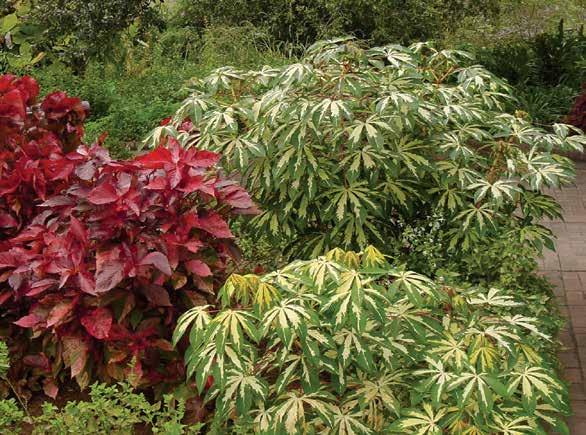
Pride-of-Barbados
Caesalpinia pulcherrima
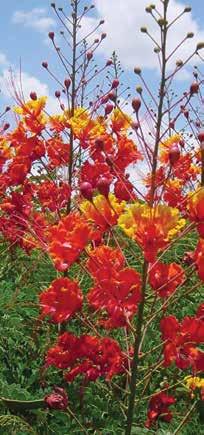
USDA Zone 8b
Pride-of-Barbados is an evergreen shrub or small tree in frost-free climates, a deciduous shrub in Zone 9, a returning perennial in Zone 8 and an annual in North and West Texas. Pride-of-Barbados dies to the ground following frost or freezing temperatures, but in Zone 8b (South Central Texas), it comes back reliably in the middle of spring. Pride-ofBarbados has incredibly showy blossoms of orange and red. The striking orange-red flowers are an attention grabber.
Exposure: Full sun.
Height: 8–12 feet.
Plant type: Summer annual, perennial or woody shrub depending upon the severity of winter temperatures.
Planting time: Spring to early summer.
Soil type: Very easy to grow in alkaline to acidic, well-drained soils.
Suggested uses: Use as a specimen or in a mixed shrub border.
Special notes: Plants tolerate very high temperatures and drought, but they do not tolerate poorly drained soils. Pride-of-Barbados is best grown in raised beds in humid climates.
Thyrallis or Shower-of-Gold
Galphimia glauca
USDA Zone 8b
As the name implies, Shower-ofGold offers season-long spikes of bright, yellow flowers. Flowers are mostly held at or above the darkgreen to blue-green foliage. With periodic pruning, plants develop a dense handsome canopy with enough flowers to draw the eye from a distance.

Exposure: Full sun to very light shade.
Height: 3–5 feet.
Plant type: Woody shrub in South Texas or summer annual in North Texas.
Planting time: Anytime from containers as a shrub, spring as a summer annual.
Soil type: Tolerant of most soils as long as they are well-drained.
Suggested uses: Generally used as an evergreen shrub in warmer portions of Texas; tolerates summer heat as a patio container; nice background for perennial or annual borders in South Texas.
Special notes: This plant blooms whenever temperatures permit. Annual pruning will maintain a denser habit, and plants work well when pruned back as a sub-shrub or herbaceous perennial.
Variegated Tapioca
Manihot esculenta ‘Variegata’
USDA Zone 11
Variegated Tapioca is a tropical plant grown as an annual in all but southern-most Texas. The variegated leaves form a chartreuse/yellow pattern. It is a non-blooming plant that offers a tropical flare to summer landscapes.
Exposure: Full or partial sun; however, plants are most colorful when grown in full sun.
Height: 4 feet tall, up to 5 feet wide.
Plant type: Annual in all but southern-most Texas.
Planting time: Spring after last frost.
Soil type: Requires a well-drained soil or container potting mix; will tolerate a wide range of pH.
Suggested uses: Container or accent plant.
Special notes: Variegated Tapioca is a heat lover and does not grow vigorously until the night temperatures are consistently above 60°F. It will exhibit chilling injury when night temperatures dip below 50°F. Keep the growing medium moist, and use mulch if planted in the soil. Plants will grow just as well in alkaline soil as they will in acidic soils. They are somewhat tolerant to foliar salt exposure in the Coastal Bend area.
Alternanthera ‘Little Ruby’WOODY SHRUBS
Woody shrubs are perennial woody plants, and therefore have persistent woody stems above ground. Usually shrubs are distinguished from trees by their height and multiple stems. Some shrubs are deciduous and others evergreen.
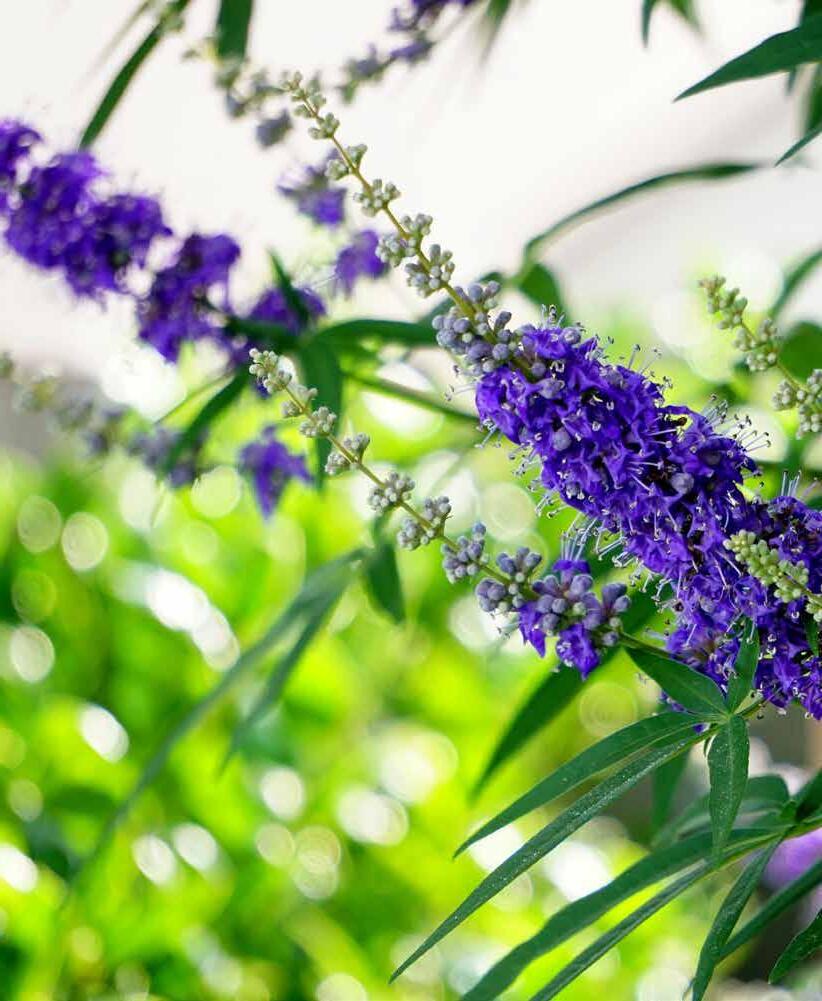
Belinda’s Dream Rose
Rosa ‘Belinda’s Dream’
USDA Zone 7
A cross between ‘Tiffany’ and ‘Jersey Beauty,’ this fast growing shrub is upright and sturdy and has bluishgreen foliage. Its blossom is a clean pink, double and high-centered rose in the classic hybrid tea style and has a rich fragrance. Blooms occur in abundance all through the warm months, especially if spent blooms are removed immediately.
Exposure: Full sun for best bloom.
Height: 5 feet.
Plant type: Shrub rose.
Planting time: Fall and spring.
Soil type: Well-drained soil is best, but they will grow in high alkaline clay soils.
Suggested uses: Shrub border, cut flowers and dried flowers for potpourri.
Special notes: Belinda’s Dream performs best in hardiness Zones 7–9. It has a bush habit and can be as wide as 4 feet. Needs day- long full sun and good air movement over the leaves. Drip irrigation or a soaker hose is recommended. The plant is occasionally attacked by black spot during the cool season, but it is usually vigorous enough to overcome the disease.
Blue AngelTM Shrub Althea
Hibiscus syriacus ‘Greba’
USDA Zone 5-8
Hibiscus syriacus ‘Greba’, marketed under the name Blue AngelTM Shrub Althea, is a delightful Hibiscus syriacus developed by Dr. Sam McFadden from crosses between ‘Bluebird’ and ‘Diane’. Hibiscus syriacus ‘Greba’ is a vigorous growing shrub to small tree with an extended blooming season featuring beautiful single blue broadly trumpet-shaped flowers. Hibiscus syriacus ‘Grewa’ is another hybrid cultivar of Dr. McFadden’s, which is a result of a cross between Hibiscus rosa-sinensis x Hibsicus syriacus ‘Diane’, that provides similar garden characteristics but a somewhat larger final size and numerous clean white flowers. Hibiscus syriacus ‘Grewa’ is marketed under the name White AngelTM Shrub Althea. Shrub Althea is at times known as Rose-of-Sharon and these shrubs have long been regional gardening favorites. These two cultivars offer tough versatile plants with reliable attractive warm season flowers.
Exposure: Best flowering is in full sun or light afternoon shade. Shady locations tend to reduce flower production.
Height: This cultivar is somewhat smaller than the typical species type, maturing at 6 to 8 feet after several years. Plants eventually form upright oval to vase-shaped habits with a spread equal to or often less than their height.
Plant type: Erect woody deciduous shrub or small tree.
Planting time: Bare root plants in early winter, container-grown or balled-and-burlapped plants year-round.
Soil type: Well drained soils are needed. Plants are usually well adapted to a range of soil pH, but may occasionally require iron chelate on very high pH soils; plants are favorably responsive to good fertility, but can persist in low to moderate fertility soils. These shrubs are moderately drought tolerant once established.
Suggested uses: Blue AngelTM can be incorporated in the landscape as a general-purpose deciduous shrub, warm season accent, limbed up as a small tree, or grown in large landscape containers. Flowers provide ecosystem services as pollinator and hummingbird attractants and are sometimes employed as cut flowers for floral arrangements. These shrubs are useful in USDA hardiness Zones 5 to 8; insufficient winter chilling can sometimes reduce or delay budbreak in warmer parts of Zone 9.
Special notes: Not to be confused with Hibiscus x moscheutos ‘Blue Angel’ which is a herbaceous perennial, not a woody shrub; avoid soils with cotton root rot; light aphid infestations can often be controlled by a removal with a strong stream of water.

Grandma’s Yellow Rose
Rosa ‘Nacogdoches’
USDA Zone 6
Grandma’s Yellow Rose repeatedly blooms from spring until the first hard frost. Its new leaves have a shade of bronze, then turn dark green. Flowers have a light and spicy fragrance. It is a repeat bloomer from spring until frost and is quite disease resistant.

Exposure: Full sun for at least six hours per day.
Height: 4–5 feet.
Plant type: Shrub rose.

Planting time: Anytime from containers.
Soil type: Well-drained slightly acidic soil is best, but it adapts to alkaline clay soils as long as drainage is adequate.
Suggested uses: Accent, shrub border with perennials, low hedges and cut flowers.
Special notes: These roses can be attacked by black spot during wet periods, mainly in the spring and fall. A few fungicide applications in the spring or during long wet periods will control the disease. Plants tolerate the disease well by readily producing new growth after defoliation.
WOODY SHRUBS
Knockout® Rose
Rosa ‘Radrazz'
USDA Zone 4
The Knockout® Rose produces fluorescent, cherry-red blooms that begin in spring and continue to provide color until the first frost.

Exposure: Full sun.
Height: 3–4 feet, but can grow up to 5 feet high and 5 feet wide when mature.
Plant type: Shrub rose.
Planting time: Anytime from containers.
Soil type: Adapts to most soils from acidic to moderately alkaline with reasonable drainage.
Suggested uses: Accent, shrub border, rose garden or low hedges.
Special notes: The Knockout® Rose grows well in planting Zones 4 through 9 and is highly tolerant of black spot, powdery mildew and aphids. It is also cold-hardy throughout the state, will grow in a wide range of soils (even highly alkaline clays), and is very heat and drought tolerant once established. The double form is more compact and has more color impact.
Lynn’s Legacy Cenizo
Leucophyllum langmaniae
‘Lynn’s Legacy’
USDA Zone 8
Lynn’s Legacy (also known as Lowery’s Legacy) was selected for its profuse and frequent flower displays. Its sage-green foliage is a wonderful backdrop for the lavender flowers. Compared to most selections of Texas sage, it is not as dependent on changes in relative humidity for flowering and can bloom more often during the course of the summer than other selections.
Exposure: Full sun.
Height: 5 feet.
Plant type: Woody shrub.
Planting time: Anytime from containers.
Soil type: Tolerant of most soils as long as they are well-drained and not soggy.
Suggested uses: General-purpose shrub where a touch of silvery foliage is desired; other uses include as a foundation shrub, in island plantings, xeriscapes or in mixed borders; with appropriate substrate, it can be used in containers on sunny patios.
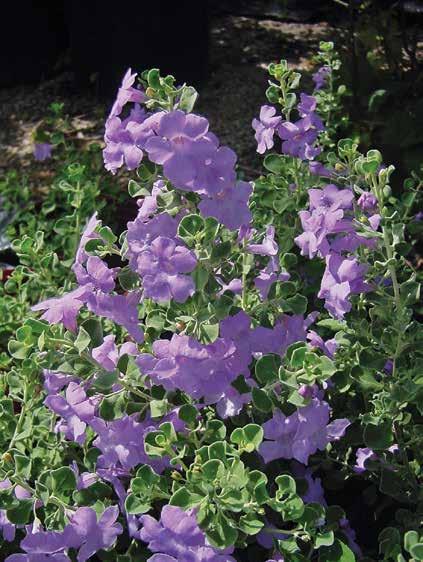
Special notes: Multiple flowering flushes frequently occur during a growing season. Be sure to avoid over watering.

Marie Daly Rose
Rosa ‘Marie Daly’
USDA Zone 5
This easy care shrub rose has few thorns and lots of very fragrant, double pink blooms. It offers successive flushes of bloom from spring to frost. Developed for Texas, this rose offers a new color of renowned antique rose ‘Marie Pavie’, as well as good disease and alkaline soil tolerance.
Exposure: Full sun.
Height: 3 feet.
Plant type: Shrub rose.

Planting time: Fall and spring.
Soil type: Well-drained soil is best, but it will grow in high alkaline clay soils.
Suggested uses: Cut flowers, dried flowers for potpourri and landscapes.
Special notes: Marie Daly Rose performs best in hardiness Zone 5. It has a bush habit and can be as wide as 3 feet. It needs daylong full sun and good air movement over the leaves. Drip irrigation or a soaker hose is recommended.
Rock Rose
Pavonia
lasiopetalaUSDA Zones 7-13
Known as Texas mallow, this rose tolerates heat, drought, and sun and keeps on blooming. This showy Texas native functions as a small shrub in and can be grown as a summer annual or container plant in colder climates. Foliage is a nice medium to dark green covered in velvety whitish pubescence, lending the leaves a bit of a dusty or frosted appearance. Flowers of rockrose look like small, 2 inch diameter, pink hibiscus blossoms. Flowers occur from spring to frost as long as good growing conditions are maintained.
Exposure: Full sun or light shade. Drought tolerance is good once plants are established.
Size: 2 to 4 ft. tall with equal or greater spread; size is site responsive, with smaller plants on thin dry Hill Country soils, and large plants in fertile garden soils.
Plant type: Rounded small woody shrub in south Texas, woody subshrub or herbaceous perennial in central Texas, annual or container plant in north Texas.

Planting time: Container grown plants from early spring through fall.
Soil type: Well drained soils are needed, prefers higher pH soils.
Suggested uses: xeriscapes, rock gardens, and informal perennial or mixed borders. Can be used as a small facer, foundation shrub, or informal hedging plant in warmer parts of the region.
Vitex, Texas Lilac, or Chaste Tree
Vitex agnus–castus
USDA Zone 7
Deciduous large shrub or small tree with distinctive palmately compound leaves. Profuse spikes of lavender flowers, blooming heavily in the early summer, and then sporadically throughout the summer and fall. Vitex is heat, drought and pest tolerant.

‘Texas Lilac’ is our group designation for several recommended cultivars including ‘Montrose Purple,’ ‘LeCompte,’ and ‘Shoal Creek,’ all of which are considered Texas Superstars.®
Exposure: Full sun; partial sun.
Height: 10–15 feet.
Width: Up to 15 feet.
Bloom time: May till frost.
Care: Vitex is coarse growing and will become a small tree quickly; flowering is more spectacular if the plant is pruned heavily after bloom.
Special Notes: A concern has been raised about the “invasive” nature of vitex. Vitex is not on the official list of noxious plants/invasive plants published by the Texas Department of Agriculture or by the USDA. Having said this, there is a concern about its weedy nature in certain areas. On the texasinvasives.org website, it is listed as “Found in limestone outcrops and dry creek beds throughout Central Texas.” We would caution persons in these favorable environments about potential weediness. The opinion of the Texas Superstar® Board is that vitex can be safely used as an ornamental in all parts of the state that do not fit this description. However, if you are in an area where vitex has been noted to behave in a weedy manner as described above or you observe a large proliferation of seedlings around ornamental plantings, we recommend that you avoid the use of vitex in your landscape.
TREES
Basham’s Party Pink Crapemyrtle
Lagerstroemia indica x Lagerstroemia faurei
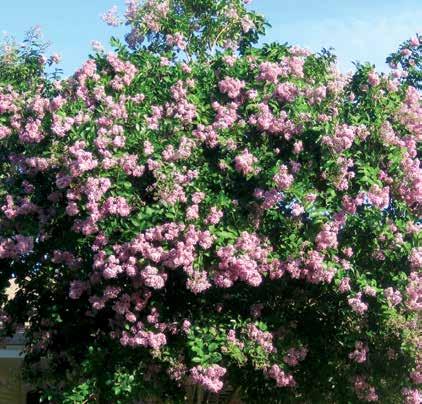
‘Basham’s Party Pink’
USDA Zone 8
Basham’s Party Pink crapemyrtle is one of the best large crapemyrtles for USDA Zone 8 and warmer locations in Texas. This beautiful tree-form crapemyrtle can be grown as a single or multiple trunk specimen maturing with beautiful fluted smooth bark, which exfoliates in shallow plates to expose predominantly light tans, gray and silver-gray bark highlighted with some reddish brown undertones. The graceful canopy is covered in spring to early summer with one or more flushes of large soft lavender-pink terminal flower clusters. The dark green foliage appears to have inherited some resistance to pests and diseases from its L. faurei heritage and a lesser propensity for seed pods than some of the other hybrids from its L. indica parentage. It was introduced to the nursery trade by the legendary Texas plantsman and nursery professional Mr. Lynn Lowrey in 1965. Makes the ‘Basham’s Party Pink’ the granddaddy of Texas hybrid crapemyrtles and a time tested Texas Superstar®
Exposure: Full sun for optimum flowering.
Height: 20–30 feet tall with two-thirds to similar spread.
Plant type: Small-to-medium single or multiple stem deciduous tree.
Planting time: Fall or early spring planting is best, but plants can be readily established from containers or balled-and-burlap at any time of year with appropriate irrigation. Soil type: Tolerant of all but very alkaline soils as long as the soil is well-drained.
Suggested uses: Specimen flowering tree, small shade tree, near patios and outdoor entertainment areas, street trees with training, in cut flower arrangements, or in very large landscape containers.
Special notes: Water during establishment and in severe drought. To reduce foliar disease problems plant where it is mostly sunny and there is good air movement. Avoiding direct irrigation spray on the foliage will also reduce disease incidence and lessen the potential for foliar damage where salty irrigation water is a problem. Plants are cold tolerant in USDA plant hardiness Zone 8 and warmer, but they should be used only in protected locations in colder climates. If frozen to the ground in a severe winter, established plants will usually regrow several feet in a single growing season.

Trees are woody perennial plants that typically have a single stem or trunk and grow to a considerable height, bearing lateral branches at some distance from the ground.
Chinkapin Oak
Quercus muehlenbergii
USDA Zone 5
Chinkapin Oak is an attractive mediumto-large shade tree suitable for use in much of Texas. Its distinctive sawtooth leaves, which resemble those of the chinquapin tree found in the eastern United States, are a rich green and turn from yellow to bronze in fall.
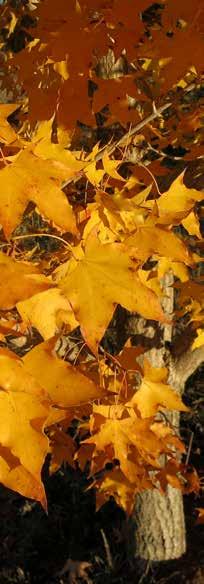

Exposure: Full sun.
Height: 50–60 feet.
Plant type: Large deciduous tree.
Planting time: Anytime from containers.
Soil type: Adapts to most soils from slightly acidic to moderately alkaline with moderate drainage.
Suggested uses: Shade tree, street tree or park tree.
Special notes: It grows in the wild on well-drained bottomland soils and limestone hills near water, but it is adaptable to a range of soils and exposures. It is moderate to fast-growing and develops an open rounded crown as it ages. Chinkapin oak is heat and drought tolerant, which makes the species widely adaptable throughout Texas.

Lacey Oak
Quercus glaucoides
USDA Zone 7
This beautiful small oak is native to the Texas Hill Country and has a spreading canopy with attractive bluish-green foliage. Lacey oaks are highly tolerant of heat, drought, alkaline soil and pests. They make wonderful shade trees for smaller yards.
Exposure: Full sun.
Height: 25 feet.
Plant type: Deciduous tree.
Planting time: Fall and spring.
Soil type: Will survive in well-drained clay soils; grows best in well-drained limestone soils.
Suggested uses: Xeriscapes or low water-use landscapes are perfect conditions for growing Lacey oak. Works best as a shade tree in a small-to-medium landscape.
Special notes: The oaks are best adapted to the western two-thirds of the state. Don’t water too frequently.
Possum Haw Deciduous Holly
Ilex decidua
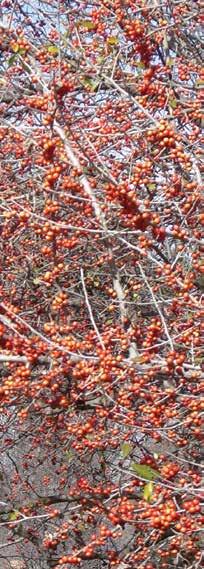
USDA Zone 5
This outstanding small native tree requires very low maintenance. It will drop its leaves in fall to reveal showy red or orange berries (on female plants) that remain throughout the winter. Possum Haw attracts songbirds while being heat and drought tolerant.
Exposure: Full sun to partial shade. Height: 10–15 feet.
Plant type: Large deciduous woody shrub or small tree.
Planting time: Anytime from containers.
Soil type: Adapts to most soils from acidic to slightly alkaline.
Suggested uses: Accent, shrub border, fall to winter specimen or as a patio tree.
Special notes: Possum Haw tolerates poorly drained soils.
Shantung Maple
Acer truncatum
USDA Zone 6
This beautiful maple has a spreading canopy with attractive foliage that turns spectacular red or red-orange in late fall. It is reminiscent of Japanese maple but much tougher.
Exposure: Full sun to partial shade.
Height: 25 feet.
Plant type: Ornamental deciduous tree.
Planting time: Fall and spring.
Soil type: Various soil types and tolerates alkaline soils.
Suggested uses: Shade tree for small yards.
Special notes: Shantung maples tolerate heat, however they are not adapted to West Texas. The trunk must be wrapped the first three years to prevent sunscald. Performs best in hardiness Zone 6.
SPECIALTY PLANTS

Arctic Frost Mandarin Hybrid
Citrus reticulata ‘Arctic Frost’
USDA Zone 8
‘Arctic Frost’ is another Mandarin hybrid resulting from a cross between the seedy but cold hardy Changsha tangerine and a very high quality Satsuma. The hybrids are the work of the late Dr. Ying Doon Moy, longtime plant breeder at the San Antonio Botanic Garden before his death in November 2012. The fruit is very sweet and tart, easy to peel and only has one or two seeds per fruit.
Exposure: Full sun; minimum of 8-10 hours per day.
Size: Eight to twelve feet high and wide in the ground; four to six feet in containers.
Plant Type: Evergreen citrus tree. Planting time: Early spring after the danger of frost has passed.

Suggested uses: Accent plant for backyard and potential patio containers.
Special notes: This Texas Superstar® should expand the planting Zone for citrus in the ground moving as far north as Zone 8; some cold protection will be required in the establishment phase of a year or two, and a site protected from the north wind is desired. Trees will be on their own roots and will come back true if frozen back; the tree will also work well in containers. Adequate fertility and a well-drained potting soil are a must in containers. Amend the mix with slow release fertilizer and water once a month with a water soluble fertilizer.
‘Balsamic Blooms’ Basil
Ocimum hybrid ‘Balsamic Blooms’
USDA Zones 9-11
‘Balsamic Blooms’ is a versatile basil from new breeding lines. This plant has attractive green foliage and deep purple blooms. Unlike most basils, the entire plant is edible so you can chop the flowers and sprinkle them on your salad to provide a nice color contrast. The foliage may be used for traditional culinary uses. The longlasting purple blooms allow this new plant introduction to be considered an excellent edible ornamental.
Exposure: Does best in full sun to maintain the colorful flowers. Space plants 18-24 inches apart.
Height: Has a mounding growth habit reaching 18-24 inches and is great for either the garden or the landscape.
Plant type: Annual with the ability to continue to grow soft new foliage while it continues to carry the purple flowers. The blooms and foliage are long lasting.
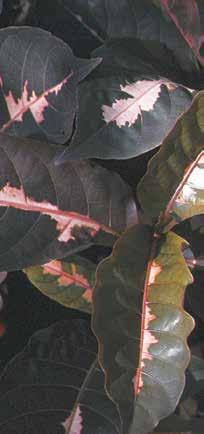

Planting time: Transplants are available in spring in several pot sizes from 4” to 1-gallon containers. Soil type: Most any well drained soil. Keep the soil slightly damp while establishing the plants and then slow the supplemental irrigation.
Suggested uses: ‘Balsamic Blooms’ is a lovely herb with multiple flavors on the same plant. Use the minty blooms to add color in a salad. The foliage has a sweeter basil flavor which may be used for pesto or other traditional culinary uses. ‘Balsamic Blooms’ is so attractive it may be used as an edible ornamental in the landscape.
Special note: ‘Balsamic Blooms’ does not require pinching or other special care, though removing older flowers will keep the plant actively growing with fresh new growth and flowers. It is also pollinator friendly!
Basket of Fire Pepper
Capsicum annuum ‘Basket of Fire’

USDA Zone 11-12
The “Basket of Fire” Pepper bred especially for hanging baskets is an edible ornamental pepper. It will thrive even in extreme heat and low humidity. With a mature height of 12 inches this little plant will spread with cascading branches to 20 inches wide. This pepper is not shy and will produce hundreds of peppers per plant! With a tolerance for cooler temperatures and the beautiful warm colors, “Basket of Fire” is a great addition to your fall garden.
Exposure: Full sun.
Height: 12–14 inches.
Spread: 20 inches.
Plant Type: Annual.
Planting Time: Spring to summer from containers.
Soil type: Adapts to most soils, but needs good drainage.
Suggested uses: Bedding or vegetable, containers, hanging baskets.
Special notes: "Basket of Fire" Pepper is hardy to USDA hardiness Zones 11-12. The flowers are small, white and star shaped. This prolific little pepper is grown mainly for its extremely showy fruits which are edible. The fruit will start out creamy in color. As the fruit matures it will deepen to yellow then orange and finish with a bright red. At any given time, all colors can be present on the plant. The fruits are relatively small, 1-2 inches, with a Scoville heat rating of approx. 80000shu. Fruit set is normally in 90 days.
Caricature Plant
Graptophyllum pictum
USDA Zone 11
Caricature Plant is an excellent summer annual for a wide range of light conditions from full sun to dense shade. Several new cultivars on the market offer foliage that varies from dark green or chocolate bronze with creamy white centers to tricolor foliage with various combinations of green, white, cream and pink.
Exposure: Full sun to dense shade. Height: 2–4 feet as an annual, to 6–8 feet as a tropical shrub.
Plant type: Summer annual (cold climates) or woody shrub (tropics).
Planting time: Anytime from containers as a shrub, late spring for use as a summer annual.
Soil type: Tolerant of most soils as long as they remain moist during the growing season.
Suggested uses: Ideal for those transition beds from sunny courtyards to the dense shade of entryways; can also be used in interiorscapes and containers.
Special notes: Caricature Plant is very heat tolerant, but it wilts under drought conditions. It is cold sensitive and can be damaged by temperatures much below 55° F.
SPECIALTY PLANTS
Celebrity Tomato Solanum lycopersicum ‘Celebrity’


The F1 hybrid plant Celebrity tomato was first produced in the USA by Colen Wyatt with the seeds being commercially distributed in the late 1980s by PetoSeed Co., today Seminis Vegetable Seeds. In 1984, the plant was judged by various experts in the field of horticulture and recognized as a recipient of the All-America Selections award due to its favorable characteristics compared to other tomato cultivars. This tomato cultivar remains a popular choice for gardeners and is the standard by which tomatoes are judged.
Exposure: Full sun.
Size: 4 to 6 feet tall.
Plant type: Perennial but grown as an annual in Texas due to cold winters.
Planting time: Best as transplants in early spring. Can be planted in midsummer for fall harvest though white flies and virus hinder production.
Soil type: Almost any well drained soil.
Suggested uses: Vigorous plants typically produce 20 or more very plump, robust tomatoes. Fruits weigh approximately 8 oz. and are 4 inches across. Plants need caging or staking and produce fruit throughout the growing season. Plants are resistant to Fusarium wilt races I and 2, Verticillium wilt, Tobacco mosaic virus and Root-knot nematode.
Special notes: Celebrity Tomatoes are resistant to splitting which usually occurs when there is an excess of water and sugar movement in the fruits. Tomatoes continue to ripen after being picked and are typically harvested when they start to change color.

‘Dwarf Cherry Surprise,’ or ‘BHN 968’ Tomato

Solanum lycopersicum ‘BHN 968’ (syn. ‘Dwarf Cherry Surprise’)
‘BHN 968’ is a determinate plant, that produces an abundant yield of cherry tomatoes. The fruit are one half to three quarter of an inch in diameter and are four times sweeter than regular cherry tomatoes. The plant is resistant to Verticillium, Fusarium, Tobacco Mossaic Virus and Tomato Spotted Wilt Virus, as well as nematodes.
Exposure: Full sun for optimum production.
Size: 3–4 feet high and 2–3 feet wide.
Plant type: Annual and determinate.

Planting time: In early spring after the danger of frost has passed and in the summer, 80 to 90 days prior to the first freeze in the fall; best to use high quality transplants; if seed is used, it should be started 6 to 8 weeks prior to the planting date.

Soil type: Numerous types as long as well-drained.
Suggested uses: For the garden or commercial planting.
Special notes: ‘BHN 968’ is an outstanding selection for the home garden or accent containers. The naturally short plant stature makes for outstanding yields in a small amount of space. Fruit sweetness and quality is exceptional. These are great for school gardens and children, as the plant will make an abundance of fruit in a short period of time.
‘Festival’ strawberry is a grower favorite because it has a sturdy bush that is easy to harvest, doesn’t yield huge quantities of fruit on any one date, and produces very few cull fruit. The fruit are attractive, fit well in one pound clamshell containers, and have a long shelf life. In addition the fruit are flavorful, firm fleshed, deep red on the outside, bright red on the inside, conically shaped, and have large, showy calyces.
Fruit Size: Medium.
Yield: Approximately 1 ½ pounds per plant.
Growth Habit: Upright rosettes and vigorous, spreading by runners; When desired, these runners are typically removed as they are formed to keep the plants compact.
Harvest Period: Typically February to May with moderate early yields.
Exposure: Full sun.
Height: 8 to 10 inches.
Plant Type: Grow as an annual.
Planting Time: Fall, late September to October.
Soil type: Sandy; needs good drainage.
Suggested uses: Raised beds, containers.
Special notes: Will tolerate freezing conditions during the winter; only needs protection when temperatures are forecast to be in the low teens.
Broccoli
A superb early hybrid variety from Calabria strains that produce high quality, attractive smooth dome heads with tight green beads.
Exposure: Full sun.
Height: Plants vary between 1–2 feet in height and spread. Heads can weigh between 350–400 gm.
Plant type: Annual.
Planting time: ‘Green Magic’ is a hybrid, which matures in 90 days from direct seeding or 60 days from transplanting. Green Magic’s superior heat tolerance makes it good for spring and fall crops, although broccoli performs best when it experiences cool growing conditions. Hence, planting date depends on location, but ideally the heads will mature when the temperatures are cool. If planting in spring, plan to harvest before the temperature reaches 80° F; the heads will bolt in high heat. If planting in fall, start 10 to 12 weeks before first frost date.
Soil type: Best in a well prepared garden soil.
Suggested uses: Good for fall and spring crops. Also, the foliage is very ornamental for mixed-use gardens. Special notes: Good tolerance to downy mildew.
‘Green Magic’ Brassica oleracea ‘Green Magic’ Festival Strawberry Fragaria × ananassa Duchesne ‘Festival’SPECIALTY PLANTS
Gorizia Rosemary
“Barbecue Skewers”
Salvia rosmarinus 'Gorizia'
USDA Zone 8
Gorizia, Rosemary is a selected variety from the northeastern part of Italy. It makes an excellent culinary herb and as an ornamental completes any EarthKind® landscape. This selection is fast growing with a vigorous upright growth habit. Its needle-like foliage which is double the size of other varieties has incredible flavor and fragrance. Their robust, straight stems are complemented with profuse sky-blue flowers that are like magnets for bees and other beneficial insects. Plants take well to pruning and are perfect for hedging, screens, and specialty topiaries or simply just left alone. This is the ideal plant for any Texan who likes to garden, cook, use dry herbs and especially barbeque as the woody stems make excellent skewers!
Exposure: Full sun, prefers drier conditions.
Size: 3-4 feet tall with 30-36 inch spread.
Plant type: Recommended to be grown as an annual as it may be cold sensitive in some parts of the state, but often flourishes as an evergreen perennial.


Planting time: Year round.
Soil type: Any type if well-draining. Suggested uses: edible gardens, centerpiece arrangements, and outdoor containers.
Special notes: Thicker woody stems make the best barbeque skewers. Strip off the leaves for use in the marinade or later for other culinary needs and soak the skewers in water for about 20 minutes. Soaking helps release the aromatics while cooking and minimizes any burning wood.
Miho Satsuma Mandarin
Citrus reticulata ‘Miho’
USDA Zone 9
Miho Satsuma produces an attractive evergreen tree with very fragrant flowers in early spring. The fruit ripens in early fall and is very sweet, easy to peel and usually seedless.
Exposure: Minimum of 8–10 hours per day.
Height: Five feet high and wide; smaller in containers.
Plant type: Evergreen citrus tree.
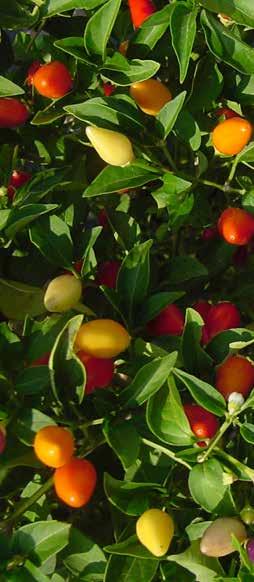

Planting time: Early spring after the danger of frost has passed.
Soil type: Adaptable if well-drained.
Suggested uses: Accent plant for the patio and containers.
Special notes: This tree performs best in hardiness Zone 9. It will flower in early spring with fruit ripening in early to late fall. If using a container, at least a 20 gallon size with good drainage is suggested. Incorporate a slow release fertilizer monthly. Containers can be moved in when a severe freeze warning is predicted. In ground plants may need some additional protection.
Moth Orchid

Phalaenopsis
USDA Zone 11
The moth orchid is one of the best orchids for growing in the home. Clumped orchid plants in small pots are usually the most spectacular bloom producers.
Exposure: Place near bright windows with no direct sun.
Height: 2 feet.
Plant type: Sub-tropical indoor plants. Planting time: Pot in late spring or early summer after blooming has completed.
Soil type: Well-draining mix such as fir bark, tree fern fiber, various types of stone, peat moss or combinations; standard potting mixes will kill them. Suggested uses: Interior plants to add color to a home or office.
Special notes: Keep the temperature above 60° F at night and between 70° F and 82° F during the day. Temperatures below 78° F for three-to-five weeks with good light are needed for initiating flower spikes. Thoroughly water and then let stand and do not water again until nearly dry. Apply a complete fertilizer on a regular schedule during the active growing season, one teaspoon per gallon of water at each watering. Potting should be done in late spring or early summer after blooming is complete.
Natchez Blackberry
Rubus fruticosus ‘Natchez’
USDA Zone 5
Natchez blackberry is a thornless cultivar out of the University of Arkansas. It is a trailing plant that produces an abundance of large, elongated fruit. The fruit is the largest produced by a thornless cultivar. Fruit quality is firm and outstanding, and it could be a commercial variety.

Exposure: Full sun for maximum production.
Height: Canes are trailing and can be 6–8 feet tall. Some sort of trellis will be needed in order to keep the canes off the ground.
Plant type: Biennial; grow a top the first year, those canes fruit the next year and then they die. The plant sends up new canes each growing season for the next year’s crop.
Planting time: Plant dormant root cuttings in early winter or plants in early spring three feet apart.
Soil type: Numerous soil types will work as long as they are welldrained. Iron chlorosis may be an issue when soil pH is over 7.8.
Suggested uses: Container patio plant or a fruit producing accent bed in the landscape.
Special notes: To maintain plant health and vigor, some of the fruit should be removed each growing season. Too much fruit can cause subsequent prima canes to be weak with a poor crop the next year.
NuMex Twilight Ornamental Pepper
Capsicum frutescens ‘NuMex Twilight’
A showy ornamental pepper that matures in about 85 days. Plants produce good yields of three-quarter of an inch long by one-half inch wide hot, edible peppers. Peppers grow upright in clusters, are very hot, and change colors from purple to yellow to orange to red when they mature. The effect is very showy against the green stems and leaves and white flowers. New growth, flowers and peppers are continually produced all season long.
Exposure: Full sun.
Height: 2 feet by 2 feet wide.
Plant type: Annual.
Planting time: From spring through late summer from containers.
Soil type: Adaptable to good soil type with good drainage.
Suggested uses: Bedding in vegetable or flower gardens, and in containers.
Special notes: These peppers can be started from seed in early spring and set out after all danger of frost has passed. Excellent for mixing vegetables into ornamental flower gardens.
SPECIALTY PLANTS
Orange Frost Mandarin Hybrid
Citrus reticulata ‘Orange Frost’
USDA Zone 8
Orange Frost Mandarin hybrid is a cross between a very cold hardy Changsha tangerine and a very high quality Satsuma. The fruit is very sweet, easy to peel and only has one or two seeds per fruit. More importantly, the tree has more cold hardiness than Satsuma and can be grown a bit further north.
Exposure: Minimum of 8–10 hours of sun per day.
Height: 8–10 feet high and wide in the ground; 4–6 feet in containers.
Plant type: Evergreen citrus tree. Planting time: Early spring after the danger of frost has passed. Soil type: Adaptable if well-drained. Suggested uses: Accent plant for backyard and potential patio containers.


Special notes: This Texas Superstar® should expand the planting Zone for citrus in the ground to as far north as Zone 8. Some protection will be required in the establishment phase. The tree will also work well in containers.
Purple Flash Ornamental Pepper

Capsicum annuum ‘Purple Flash’
An exotic-looking ornamental pepper with leaves that are almost black and overlaid with splashes of dark purple and white. Fruit are small and secondary to the foliage for display.
Exposure: Full sun to partial shade.
Height: 12–15 inches.
Plant type: Annual.
Planting time: Spring.
Soil type: Will grow in most welldrained soils and in a variety of potting mixes.
Suggested uses: A great vegetable to mix in flower borders, use in mass plantings or in containers.
Special notes: Plants are heat and drought tolerant. Fruits are extremely hot to the taste.
Satsuma Mandarin
Citrus reticulata
USDA Zone 9
Satsuma Mandarin is one of the most cold tolerant citrus for Texas. The tree has attractive, evergreen foliage and produces white flowers with an awesome fragrance. The fruit is very sweet, juicy, easy to peel and usually seedless.
Exposure: Minimum of 8–10 hours of sun per day.
Height: 8–10 feet high and wide on a rootstock in the ground; 3–4 feet in a container.
Plant type: Evergreen citrus tree.

Planting time: Early spring after danger of frost has passed.
Soil type: Adaptable if well-drained.
Suggested uses: Accent plant for the patio and containers.
Special notes: This plant performs best in hardiness Zone 9. It will flower in early spring with fruit ripening in early to late fall. Containers should be at least 20 gallons with good drainage. Incorporate a slow release fertilizer monthly. Containers can be moved in when a severe freeze warning is predicted. In ground plants, you may need some additional protection.
‘Tycoon’
Tomato
Solanum lycopersicum ‘Tycoon’

‘Tycoon’ is an exceptional large rounded beef slicer tomato variety. The plant is determinate and is known for its heat setting ability as well as its resistance to tomato yellow leaf curl virus. This particular virus has become a major problem in the fall over the past few years as the virus is transmitted by white flies, which become worse in serious drought conditions. In addition, the plant is resistant to Verticillium, Fusarium races one and two, tomato spotted wilt virus, as well as nematodes. The fruit is firm and actually more oblate than round.
Exposure: Full sun for optimum production.
Size: Plants are 3–4 feet high and 2–3 feet wide. Average fruit size is 10 ounces, but reports up to 1.5 pounds have been recorded. Plant has the capacity of yielding 25 to 30 pounds of high quality marketable fruit.
Plant type: Annual determinate type.
Planting time: In early spring, after the danger of frost has passed and in the summer, 80-90 days to the first freeze in the fall; best to use high quality transplants; if seed is used, it should be started 6 to 8 weeks prior to the planting date.
Soil type: Numerous types as long as well-drained.
Suggested uses: For the garden or commercial planting.
‘Victoria Red’ Grape
Vitis species ‘Victoria Red’
USDA Zone 7b or warmer
The University of Arkansas, Texas
A&M AgriLife Extension Service and Tarkington Vineyards have released a Pierce’s disease (PD) tolerant grape variety named ‘Victoria Red’. Evaluated as Arkansas 1475, ‘Victoria Red’ was bred in 1971. It has been shown to be very tolerant to Pierce’s disease (Xylella fastidiosa) referred to as “PD”. The most significant characteristic of ‘Victoria Red’ is its sustained health, vigor and productivity in Coastal Texas, an area of the United States with extremely high PD pressure. It is a seeded grape with both large berries and clusters that are attractive and quite long with a bright red skin color. Average cluster weight at Tarkington Vineyards near Victoria, TX exceeded one pound. The Tarkington Vineyards’ location is approximately 40 miles from the Gulf of Mexico and has very intense PD pressure. Vines at this location were vigorous and productive for twenty years while all other susceptible varieties died rapidly from PD.

Exposure: Does best in full sun and wide spacing; 8 to 10 feet apart
Height: Will grow luxuriantly; best not to over fertilize and prune to keep in bounds each year.
Plant type: Perennial; can suffer some freeze damage as you move further north.
Planting time: Bare root plants in early winter.
Soil type: Well drained; may require iron chelate on high pH soil. Suggested uses: ‘Victoria Red’ is recommended primarily as a freshfruit cultivar in USDA hardiness Zones 7b or warmer. ‘Victoria Red’ is typically a two seeded berry with an occasional third seed trace. In addition to yield and quality potential, ‘Victoria Red’ has loose clusters which appears to make it resistant to bunch rot organisms common on more tightly clustered varieties.
Special note: A major limitation of this variety can be its lack of cold hardiness as it routinely suffered cane and trunk injury in West-Central Arkansas. However, it has been grown successfully in the Lubbock area, but obviously has some occasional freeze damage.
USDA HARDINESS ZONES
Texas Superstars® perform best at the hardiness Zones indicated. However, Texas Superstars® are widely adapted across the state. The Zone indicated is the coldest Zone for which a plant is adapted. These plants can also be grown in warmer Zones. Summer annuals do not have a hardiness designation, but winter annuals do.
Due to the wide diversity in climatic conditions across Texas, some perennial plants may be treated as annuals.

NEED ADVICE?
These are the locations in the state where official Texas Superstar® trial sites are located. They represent parts of Texas with varying rainfall amounts, temperature patterns, and soil types.


The maps were prepared by the U.S. Department of Agriculture.
Contact your local Extension Agent for advice on which plants will work best in your area.

ADDITIONAL INFORMATION
Explanation of Symbols
Water Use
The number of raindrop symbols denotes the level of water use that can be expected for a particular plant. Even the most drought tolerant plants need adequate moisture for initial establishment.

= Low expected water use
= Moderate expected water use
= High expected water use
Texas Superstar® Deer-resistant plants

The designated deer symbol indicates “deer resistant plants.” Deer tend to avoid some plants and relish others. While no plant can be guaranteed to be “deer-proof,” some types of plants are less appealing to the animals. Highly recommended by many gardeners is a good deer repellent to prevent deer damage for a six month time period after planting for plant establishment.
Attractive to pollinators
The bee symbol indicates that the designated plant is attractive to pollinators. This could include honey bees, bumble bees, or any other pollinators that are commonly found in gardens of a particular area.
 Visit the Stephens Family Texas Superstar Garden, part of the seven-plus acre Leach Teaching Gardens on the campus of Texas A&M University in College Station.
Photo by Ed Rhodes
Photo by Ed Rhodes
Visit The Gardens at Texas A&M University, "Where inspiration and spirit bloom." The gardens are located at 556 John Kimbrough Boulevard, College Station, TX 77843. Find out more at https://gardens.tamu.edu.
Visit the Stephens Family Texas Superstar Garden, part of the seven-plus acre Leach Teaching Gardens on the campus of Texas A&M University in College Station.
Photo by Ed Rhodes
Photo by Ed Rhodes
Visit The Gardens at Texas A&M University, "Where inspiration and spirit bloom." The gardens are located at 556 John Kimbrough Boulevard, College Station, TX 77843. Find out more at https://gardens.tamu.edu.
Contact Information
Proving that Texas Superstars® are outstanding landscape plants specifically adapted to Texas
Texas A&M AgriLife Extension Service - Smith County
1517 West Front St., Suite 116 Tyler, Texas 75702
Phone: 903-590-2980
www.texassuperstar.com
Texas A&M AgriLife Extension Service - Bexar County
3355 Cherry Ridge St. Ste 212
San Antonio, TX 78230
Phone: 210-631-0400
www.texassuperstar.com
Texas Nursery & Landscape Association


A Texas trade association representing grower, retail, landscape and supplier segments of the nursery and landscape industry
7730 South IH-35
Austin, Texas 78745
Phone: (512) 280-5182
Fax: (512) 280-3012
www.tnlaonline.org
www.landscapetexas.org

GO TEXAN
Promotes the products, culture and communitities that call Texas home.
P.O. Box 12847
Austin, Texas 78711
Phone: (877) 99-GOTEX
For the hearing impaired: (800) 735-2989 (TTY)
www.gotexan.org
Texas Superstar® Videos
Watch the “Texas Superstar® Overview Video” at: http://www.youtube.com/watch?v=sUwk7zDONoE
See Tom Spencer, host of Central Texas Gardener on KLRU, interview Brent Pemberton, chair of the Executive Board at Texas Superstar®, about the Texas Superstar® Program at:
http://www.youtube.com/watch?v=9QAcX5IstCI
Ask
QUESTIONS?




